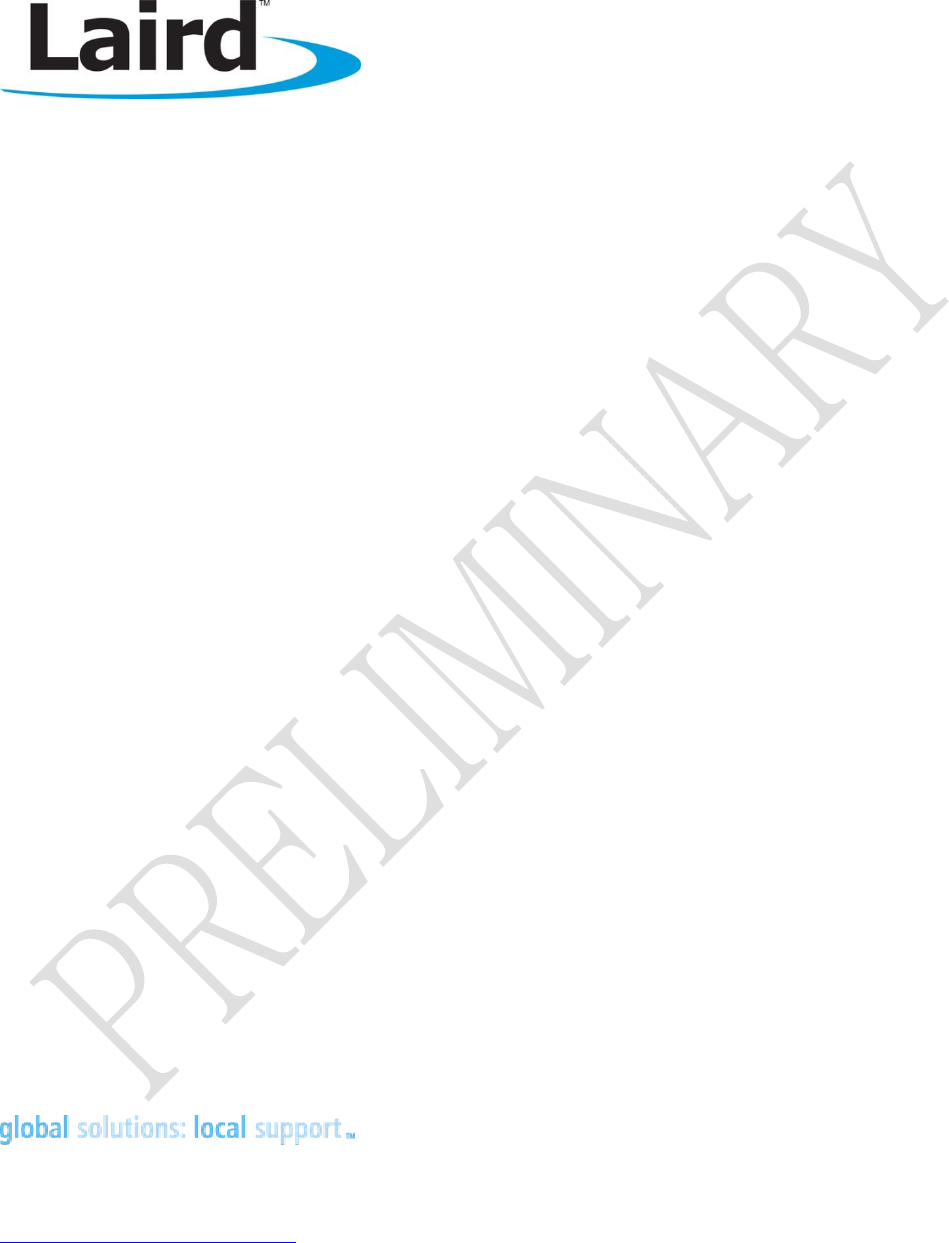Laird Connectivity BT800 BTv4.0 Dual Mode USB HCI Module / BTv4.0 Dual Mode USB HCI Module (BG carrier board) / BTv4.0 Dual Mode USB Dongle User Manual
Laird Technologies BTv4.0 Dual Mode USB HCI Module / BTv4.0 Dual Mode USB HCI Module (BG carrier board) / BTv4.0 Dual Mode USB Dongle
User manual
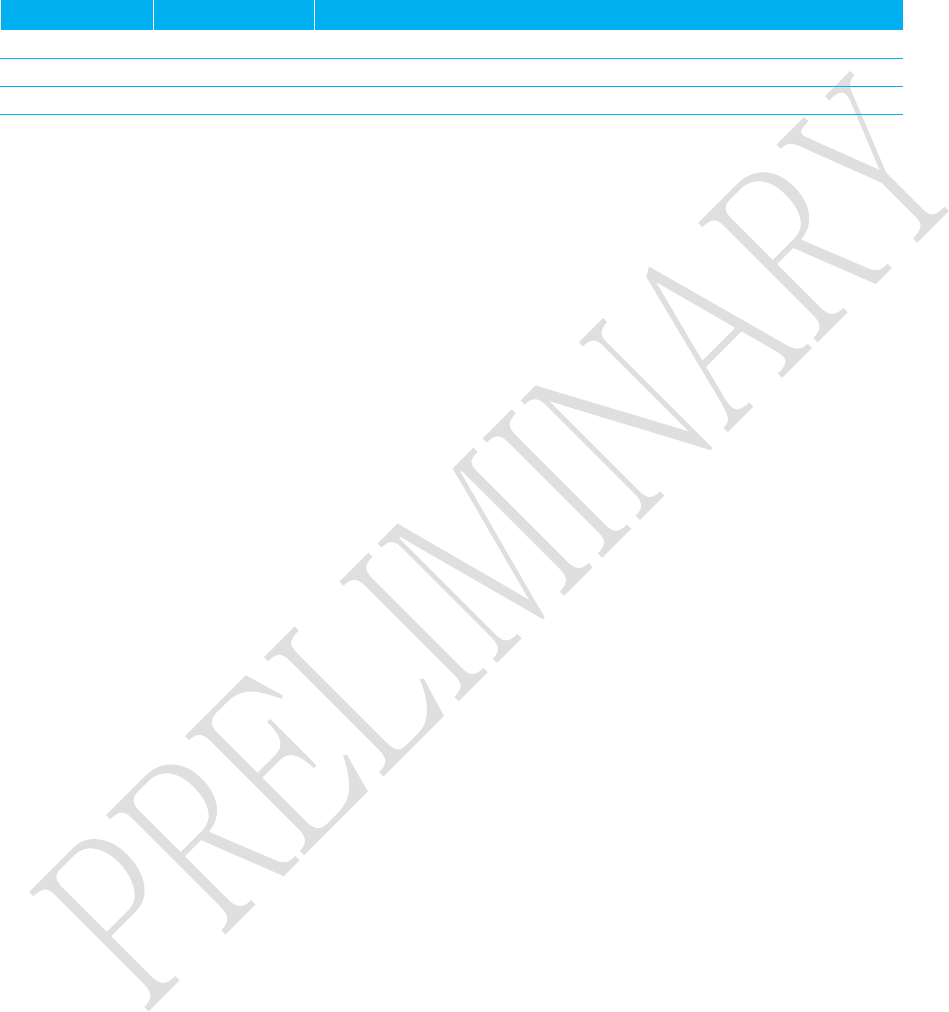
BT800 Hardware Integration Guide
Version 0.2
Americas: +1-800-492-2320 Option 2
Europe: +44-1628-858-940
Hong Kong: +852-2923-0610
www.lairdtech.com/bluetooth
2
CONN-GUIDE-BT800_v0_2
REVISION HISTORY
Revision
Date
Changes
Version 0.1
7/8/2013
Preliminary
Version 0.2
10/07/13
Initial – KP only
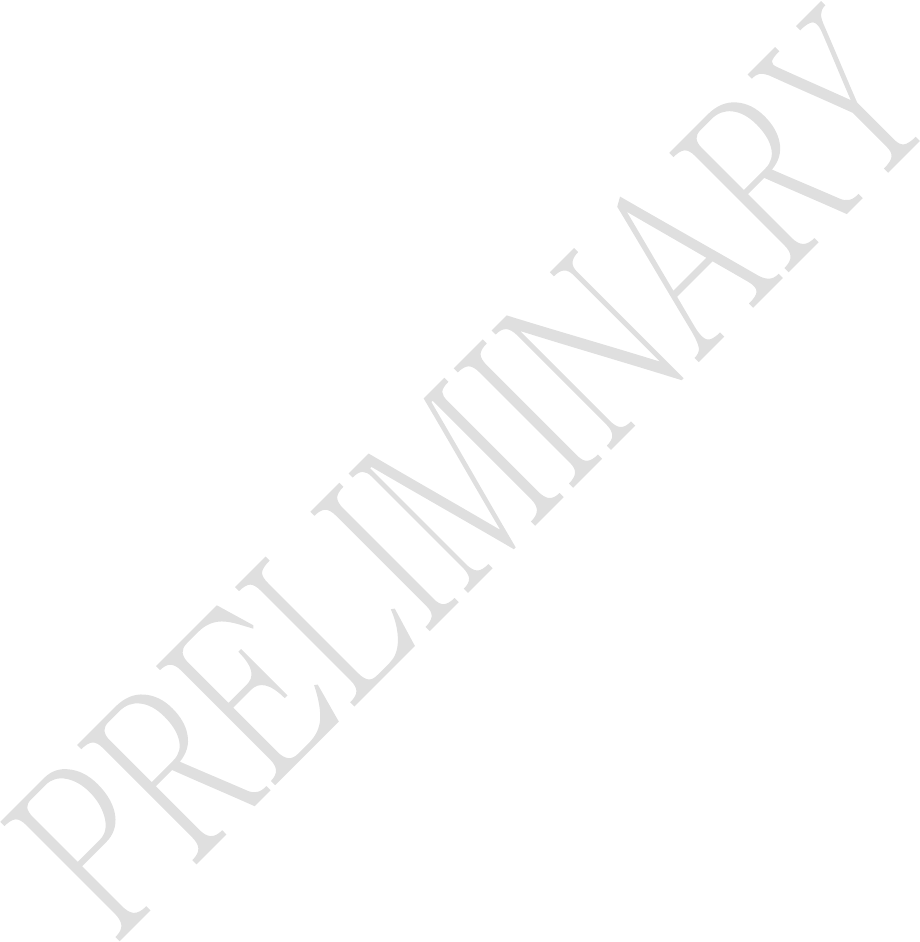
BT800 Hardware Integration Guide
Version 0.2
Americas: +1-800-492-2320 Option 2
Europe: +44-1628-858-940
Hong Kong: +852-2923-0610
www.lairdtech.com/bluetooth
3
CONN-GUIDE-BT800_v0_2
CONTENTS
Revision History .......................................................................................................................... 2
Contents ..................................................................................................................................... 3
1 Scope .................................................................................................................................... 5
2 Operational Description ......................................................................................................... 5
Features & Benefits ............................................................................................................................ 5 2.1
Application Areas .............................................................................................................................. 5 2.2
3 Module picture ...................................................................................................................... 6
4 Block Diagram and Descriptions ............................................................................................ 7
Main Chip: CSR8510A10 ................................................................................................................... 7 4.1
Antenna ............................................................................................................................................... 7 4.2
Band Pass Filter ................................................................................................................................... 7 4.3
EEPROM ............................................................................................................................................... 7 4.4
Crystal .................................................................................................................................................. 7 4.5
5 Specifications ........................................................................................................................ 8
6 Pin definitions ....................................................................................................................... 9
7 DC Electrical Characteristic .................................................................................................. 11
8 RF Characteristics ................................................................................................................ 13
9 Interface .............................................................................................................................. 14
PIO (Programmable I/O Ports) ...................................................................................................... 14 9.1
WLAN Coexistence Interface ........................................................................................................ 14 9.2
USB Interface .................................................................................................................................... 14 9.3
PCM Interface .................................................................................................................................. 15 9.4
GCI Interface .................................................................................................................................... 17 9.5
Slots and Sample Formats .............................................................................................................. 17 9.6
PCM Timing Information
................................................................................................................... 18 9.7
PCM Slave Timing ............................................................................................................................ 20 9.8
PCM Slave Mode Timing Parameters .......................................................................................... 20 9.9
PCM_CLK and PCM_SYNC Generation ...................................................................................... 22 9.10
PCM Configuration .......................................................................................................................... 22 9.11
Digital Audio Interface (I²S) ............................................................................................................ 22 9.12
10 Power Control and Regulation ............................................................................................. 25
USB Linear Regulator ....................................................................................................................... 25 10.1
High-voltage Linear Regulator ...................................................................................................... 25 10.2
Low-voltage VDD_DIG Linear Regulator ..................................................................................... 26 10.3
Low-voltage VDD_RADIO Linear Regulator ................................................................................ 26 10.4
Low-voltage VDD_AUX Linear Regulator .................................................................................... 26 10.5
Voltage Regulator Enable and Reset .......................................................................................... 26 10.6
Power Sequencing .......................................................................................................................... 26 10.7
11 Antenna performance .......................................................................................................... 27
12 Mechanical Dimensions and Land Pattern ............................................................................ 29
13 Implementation note ........................................................................................................... 30
PCB Layout on Host PCB ................................................................................................................ 30
13.1
14 Application Note for Surface Mount Modules ....................................................................... 32
Introduction ...................................................................................................................................... 32 14.1
Shipping tray ..................................................................................................................................... 32 14.2
Reflow Parameters .......................................................................................................................... 32 14.3
15 FCC and IC Regulatory ......................................................................................................... 34
Documentation Requirements ..................................................................................................... 34 15.1
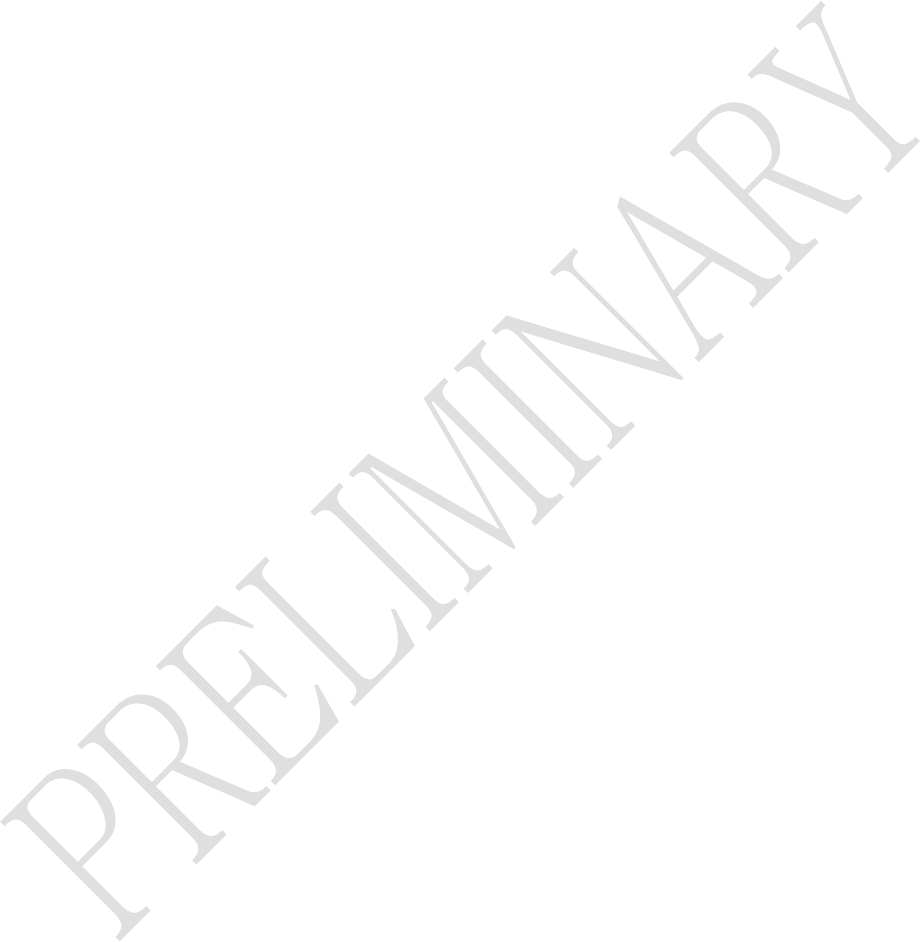
BT800 Hardware Integration Guide
Version 0.2
Americas: +1-800-492-2320 Option 2
Europe: +44-1628-858-940
Hong Kong: +852-2923-0610
www.lairdtech.com/bluetooth
4
CONN-GUIDE-BT800_v0_2
16 European Union Regulatory ................................................................................................. 38
17 EU Declarations of Conformity ............................................................................................. 38
BT800 / BT810 / BT820 ....................................................................................................................... 38 17.1
18 Ordering Information........................................................................................................... 39
General Comments ........................................................................................................................ 39 18.1
19 Bluetooth SIG Approvals ...................................................................................................... 40
TBC 40
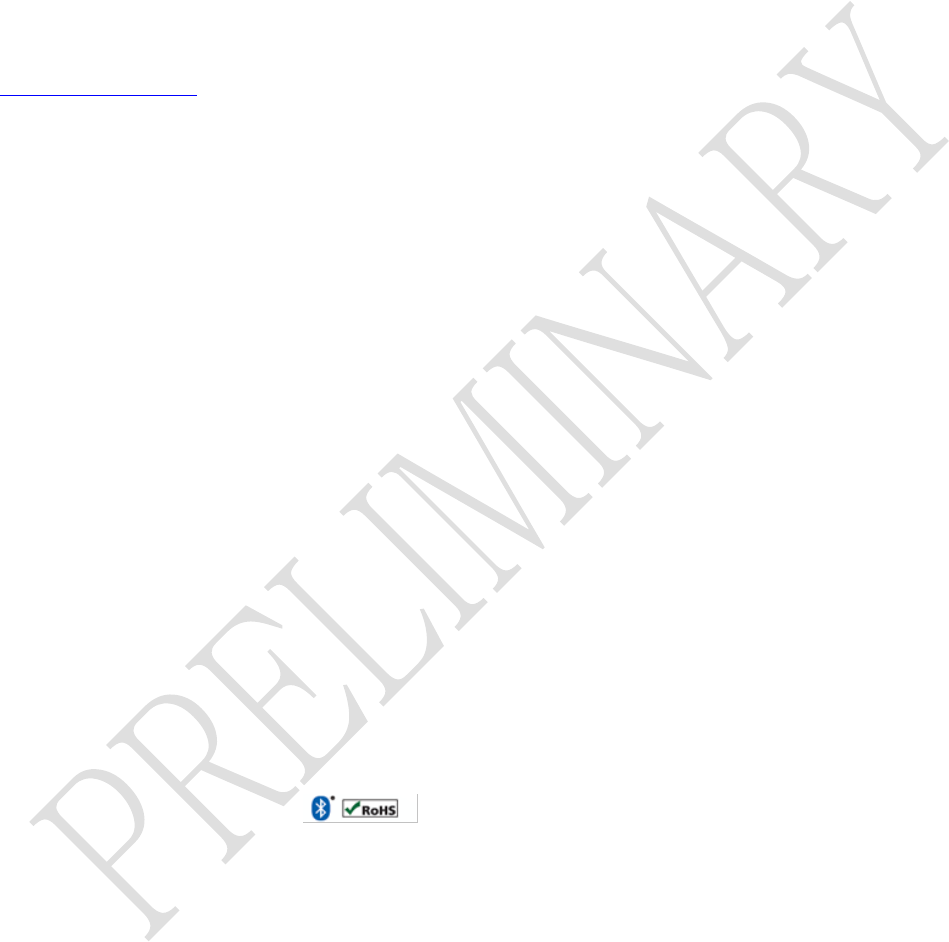
BT800 Hardware Integration Guide
Version 0.2
Americas: +1-800-492-2320 Option 2
Europe: +44-1628-858-940
Hong Kong: +852-2923-0610
www.lairdtech.com/bluetooth
5
CONN-GUIDE-BT800_v0_2
1 SCOPE
This document describes key hardware aspects of the Laird BT800 Bluetooth HCI/HID module. This
document is intended to assist device manufacturers and related parties with the integration of this
module into their host devices. Data in this document are drawn from a number of sources including
data sheets for the CSR CSR8510.
Because the BT800 is currently in development stage, this document is preliminary and the information
in this document is subject to change. Please contact Laird Technologies or visit the Laird website at
www.Lairdtech.com to obtain the most recent version of this document.
2 OPERATIONAL DESCRIPTION
The BT800 series of USB HCI devices are designed to meet the needs of OEMs adding robust Bluetooth
connectivity and using embedded Bluetooth stacks within these products.
Leveraging the market-leading CSR 8510 chipset, the BT800 series provides exceptionally low power
consumption with outstanding range. Supporting the latest Bluetooth v4.0 Specification with EDR
(Enhanced Data Rate), the Laird BT800 series enables OEMs to accelerate their development time for
leveraging either Classic Bluetooth or Bluetooth Low Energy (BLE) into their operating system based
devices.
With a tiny footprint as small as 8.5 x 13 mm, yet output power at 8 dBm, these modules are ideal for
applications where designers need high performance in minimal size. For maximum flexibility in systems
integration, the modules are designed to support a full speed USB interface plus GPIO and additionally
I2S and PCM audio interfaces.
These modules present an HCI interface and have native support for Windows and Linux Bluetooth
software stacks. All BT800 series devices are fully qualified as Bluetooth Controller Subsystem products.
This also allows designers to integrate their existing pre-approved Bluetooth Host and Profile subsystem
stacks to gain a Bluetooth END product approval for their products.
The BT800 series is engineered to provide excellent RF performance with integrated antenna and
additional band pass filters. It further reduces regulatory and testing requirements for OEMs and ensures
a hassle free development cycle. As an additional benefit of the BT8000 series, Laird has implemented
CSR’s HID (Human Interface Device) Proxy Mode enabling out of the box HID connectivity for pointing
devices and / or keyboard functionality, requiring zero host device software or configuration.
A fully featured, low-cost developer’s kit is available for prototyping, debug and integration testing of
the BT800 series modules and further reduces risk and time in development cycles.
Features & Benefits
2.1
Application Areas
2.2
Bluetooth v4.0 - Dual mode
- Classic Bluetooth and Bluetooth Low Energy
Compact footprint
2-wire and 3-wire Wi-Fi coexistence scheme
High antenna radiation gain and efficiency
Good interference rejection for multi-com system
(GSM/WCDMA)
Class 1 output – 8 dBm
USB, GPIO, I2S, and PCM
Industrial Temperature Range
Medical devices
ePOS terminals
Barcode scanners
Industrial Cable Replacement
M2M Connectivity
Automotive Diagnostic Equipment
Personal Digital Assistants (PDA)
Bluetooth HID device (keyboard,
mouse, and joystick)
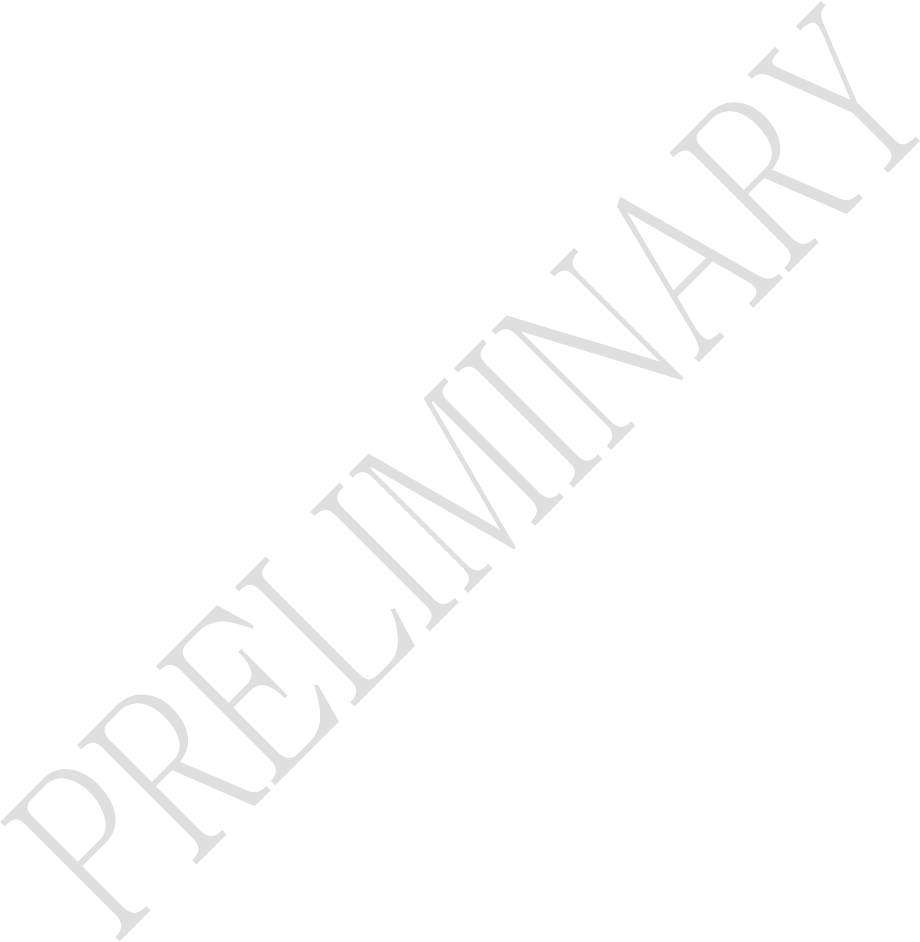
BT800 Hardware Integration Guide
Version 0.2
Americas: +1-800-492-2320 Option 2
Europe: +44-1628-858-940
Hong Kong: +852-2923-0610
www.lairdtech.com/bluetooth
6
CONN-GUIDE-BT800_v0_2
64 k EEPROM support for HID Proxy mode
Bluetooth Controller subsystem
FCC, IC, CE, and MIC approvals
3 MODULE PICTURE
TBA
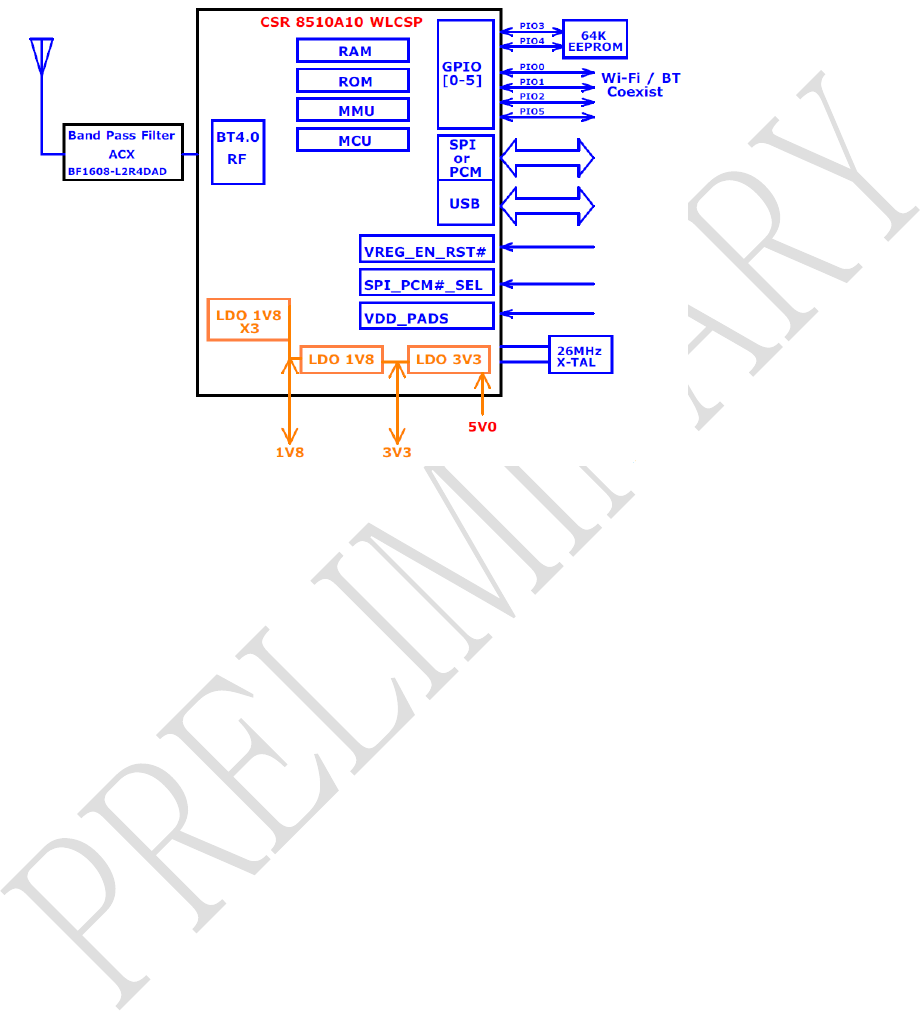
BT800 Hardware Integration Guide
Version 0.2
Americas: +1-800-492-2320 Option 2
Europe: +44-1628-858-940
Hong Kong: +852-2923-0610
www.lairdtech.com/bluetooth
7
CONN-GUIDE-BT800_v0_2
4 BLOCK DIAGRAM AND DESCRIPTIONS
Figure 1: BT800 module block diagram
Main Chip: CSR8510A10 4.1
BT800 is based on CSR8510A10 dual mode chip. The chip is a single-chip radio with on chip LDO
regulators and baseband IC for Bluetooth 2.4 GHz systems including EDR to 3 Mbps. Dedicated signal
and baseband processing is included for full Bluetooth operation. The chip provides SPI/PCM and USB
interfaces. Up to 4 general purpose I/Os are available for general usage, such as Wi-Fi coexistence or
general indicators.
Antenna 4.2
Antenna is a ceramic monopole chip antenna.
Band Pass Filter 4.3
The band pass filter filters the out of band emissions from the transmitter to meet the specific regulations
for type approvals of various countries.
EEPROM 4.4
There are 64 k bits EEPROM embedded on the BT800 module which can be used to store customizable
parameters, such as maximum TX power, PCM configuration, USB product ID, USB vendor ID and USB
product description. With that, the BT800 module can support HID/HCI Proxy Mode.
Crystal 4.5
The embedded 26 MHz crystal is used for generating the clock for the entire module.
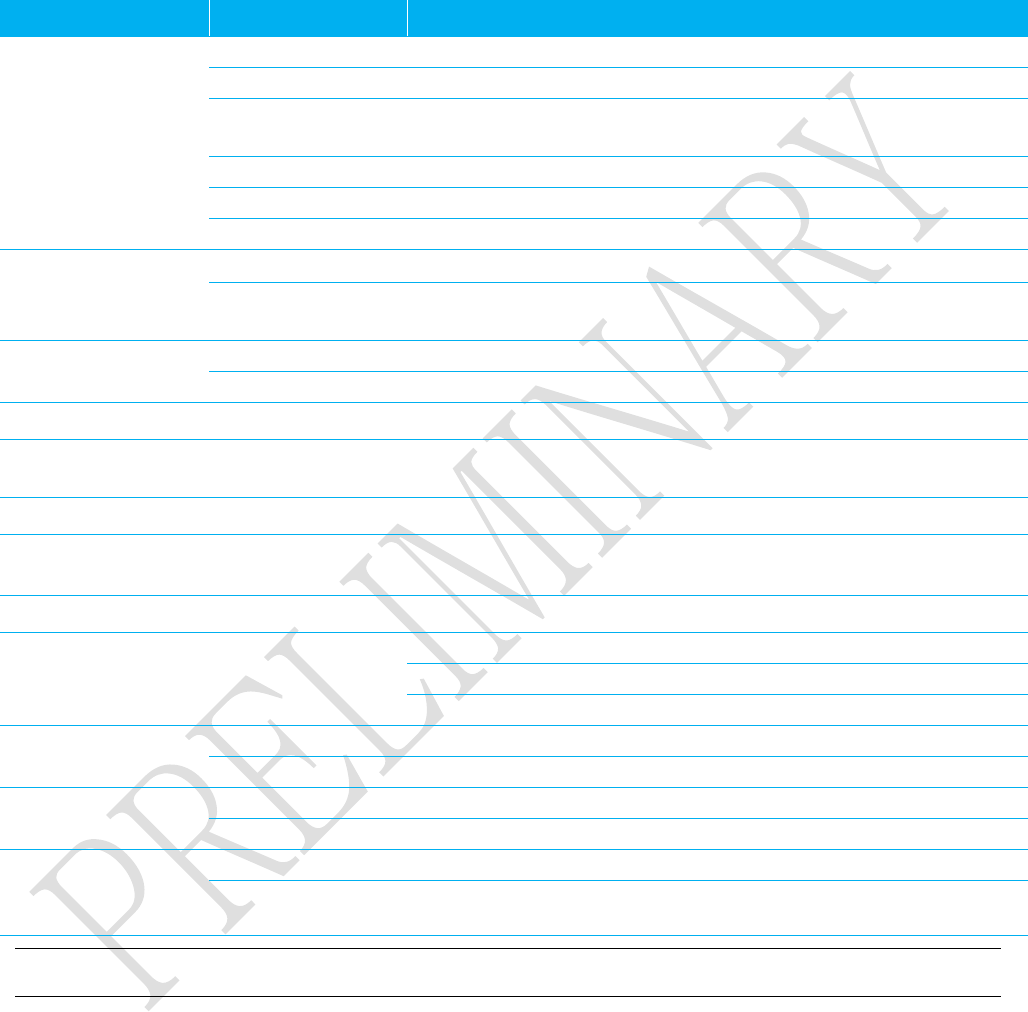
BT800 Hardware Integration Guide
Version 0.2
Americas: +1-800-492-2320 Option 2
Europe: +44-1628-858-940
Hong Kong: +852-2923-0610
www.lairdtech.com/bluetooth
8
CONN-GUIDE-BT800_v0_2
5 SPECIFICATIONS
CATEGORIES
FEATURE
IMPLEMENTATION
Wireless
Specification
Bluetooth®
V4.0 Dual Mode
Frequency
2.402 - 2.480 GHz
Max Transmit
Power
Class 1
+8dBm from antenna
Receive Sensitivity
-89dBm
Range
Circa 100 meters
Data Rates
Up to 3 Mbps (over the air)
Host Interface
USB
Full Speed USB 2.0
GPIO
4 configurable lines
(1.8V/3.3V configurable by VDD_PADS)
Operational
Modes
HCI
Host Controller Interface over USB
HID Proxy Mode
Human Interface Device
EEPROM
2-wire
64K bits
Coexistence
802.11 (Wi-Fi)
3 wire CSR schemes supported
(Unity-3;Unity-3e and Unity+)
Supply Voltage
Supply
5V +/-10% (Note:1)
Power
Consumption
Current
Idle (sleep) < TBC mA
Connectable & Discoverable < TBC mA
Antenna Option
Internal
Multilayer ceramic antenna with up to 41% efficiency.
Physical
Dimensions
8.5 x 13 x 1.6 mm (BT800 - Module)
9.3 x 13.05 x 2.3mm (BT810 – Module BG)
16 x 43 x 11 (BT820 – USB Dongle)
Environmental
Operating
-40C to +85C
Storage
-40C to +85C
Miscellaneous
Lead Free
Lead-free and RoHS compliant
Warranty
1 Year
Approvals
Bluetooth®
Controller Subsystem Approved
FCC / IC / CE /
MIC
All BT800 series
Note: Different DC power selections on BT800 are detailed in “
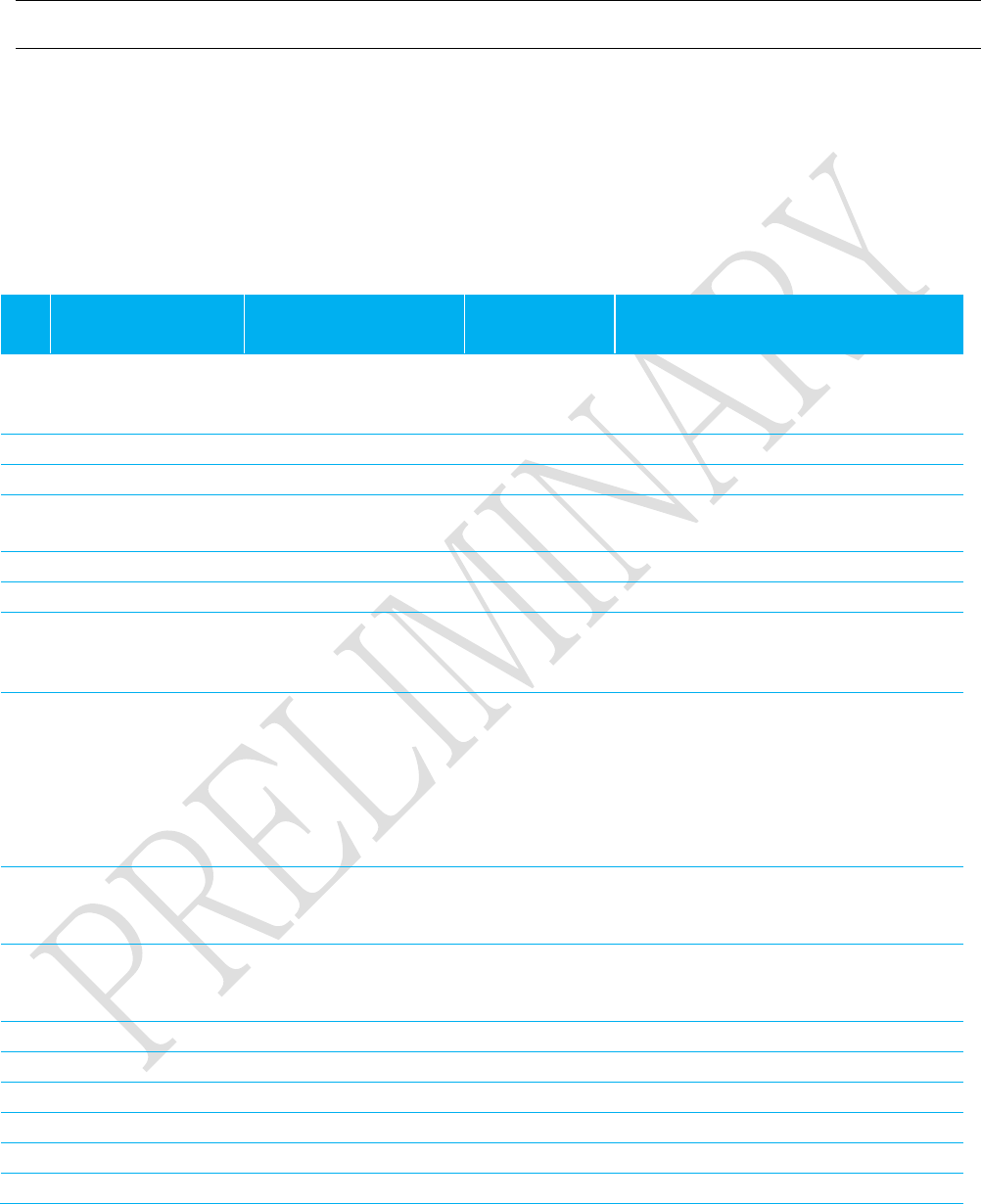
BT800 Hardware Integration Guide
Version 0.2
Americas: +1-800-492-2320 Option 2
Europe: +44-1628-858-940
Hong Kong: +852-2923-0610
www.lairdtech.com/bluetooth
9
CONN-GUIDE-BT800_v0_2
Implementation note.”
6 PIN DEFINITIONS
#
Pin Name
I/O
Supply
Domain
Description
1
SPI_PCM#_SEL
Input with
weak
internal
pull-down
VDD_PADS
High switches SPI/PCM lines to
SPI,
Low
switches SPI/PCM lines
to
PCM/PIO
2
VDD_HOST
Power supply
(3.1V-3.6V)
USB system positive supply
3
GND
GND
-
Ground
4
USB+
Bidirectional
VDD_HOST
USB data plus with selectable
internal 1.5kΩ pull-up resistor
5
USB-
Bidirectional
VDD_HOST
6
GND
GND
-
Ground
7
VREG_IN_USB
Power supply
Analogue
regulator
input
Input to USB regulator. Connect to
external
USB bus supply, e.g. USB_VBUS
8
VREG_EN_RST#
Input with strong
internal pull-down
VDD_PADS
Take high to enable internal
regulators. Also acts as active low
reset. Maximum voltage is
VDD_PADS.
Note: USB regulator is always
enabled and not controlled by
this pin
9
VREG_IN_HV
Analogue regulator
input / output
3.3V
Input to internal high-voltage
regulator to 1.8V regulator, 3.3V
output from USB regulator.
10
VREG_OUT_HV
Analogue regulator
input / output
1.8V
Output from internal high-voltage
to 1.8V regulator. Input to second
stage internal regulators.
11
GND
GND
-
Ground
12
GND
GND
-
Ground
13
GND
GND
-
Ground
14
GND
GND
-
Ground
15
GND
GND
-
Ground
16
GND
GND
-
Ground
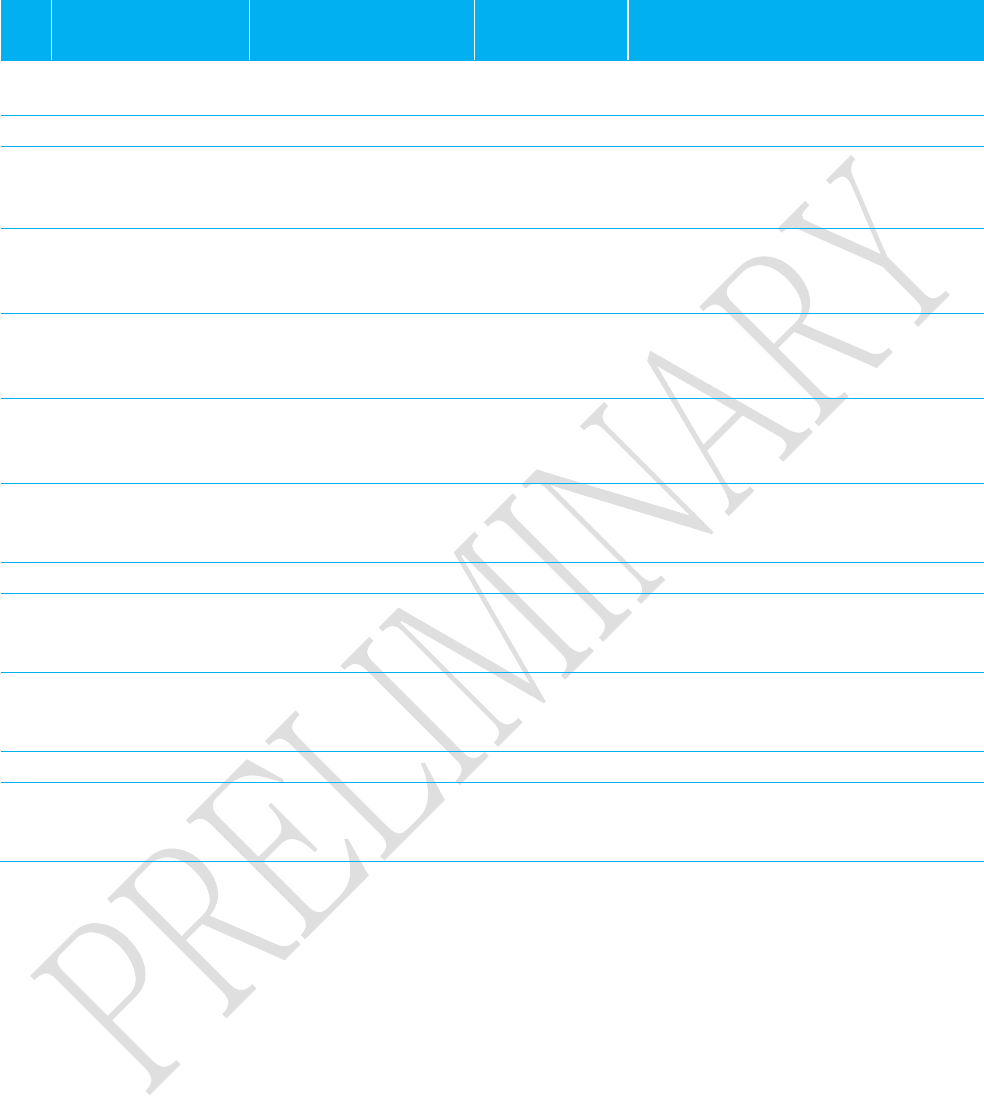
BT800 Hardware Integration Guide
Version 0.2
Americas: +1-800-492-2320 Option 2
Europe: +44-1628-858-940
Hong Kong: +852-2923-0610
www.lairdtech.com/bluetooth
10
CONN-GUIDE-BT800_v0_2
#
Pin Name
I/O
Supply
Domain
Description
17
N/C
-
-
This pin is reserved for future used.
No connection.
18
GND
GND
-
Ground
19
PCM_SYNC/
SPI_CS#/
PIO23
Bidirectional,
tri-state, with weak
internal pull-down
VDD_PADS
PCM synchronous data sync SPI
chip select, active low
Programmable input/output line
20
PCM_CLK/
SPI_CLK/
PIO24
Bidirectional,
tri-state, with weak
internal pull-down
VDD_PADS
PCM synchronous data clock
SPI clock
Programmable input/output line
21
PCM_IN/
SPI_MOSI/
PIO21
Input, tri-state, with
weak internal pull-
down
VDD_PADS
PCM synchronous data input
SPI data input
Programmable input/output line
22
PCM_OUT/
SPI_MISO/
PIO22
Output, tri-state, with
weak internal pull-
down
VDD_PADS
PCM synchronous data output
SPI data output
Programmable input/output line
23
PIO0/
WLAN_ACTIVE
Bidirectional,
tri-state, with weak
internal pull- down
VDD_PADS
Programmable input/output line
24
GND
GND
-
Ground
25
PIO1/
BT_PIRORITY
Bidirectional,
tri-state, with weak
internal pull- down
VDD_PADS
Programmable input/output line
26
PIO2/
BT_ACTIVE
Bidirectional,
tri-state, with weak
internal pull- down
VDD_PADS
Programmable input/output line
27
VDD_PADS
Power supply
(1.7V-3.6V)
Positive supply for digital I/O pads
28
PIO5
Bidirectional,
tri-state, with weak
internal pull- down
VDD_PADS
Programmable input/output line
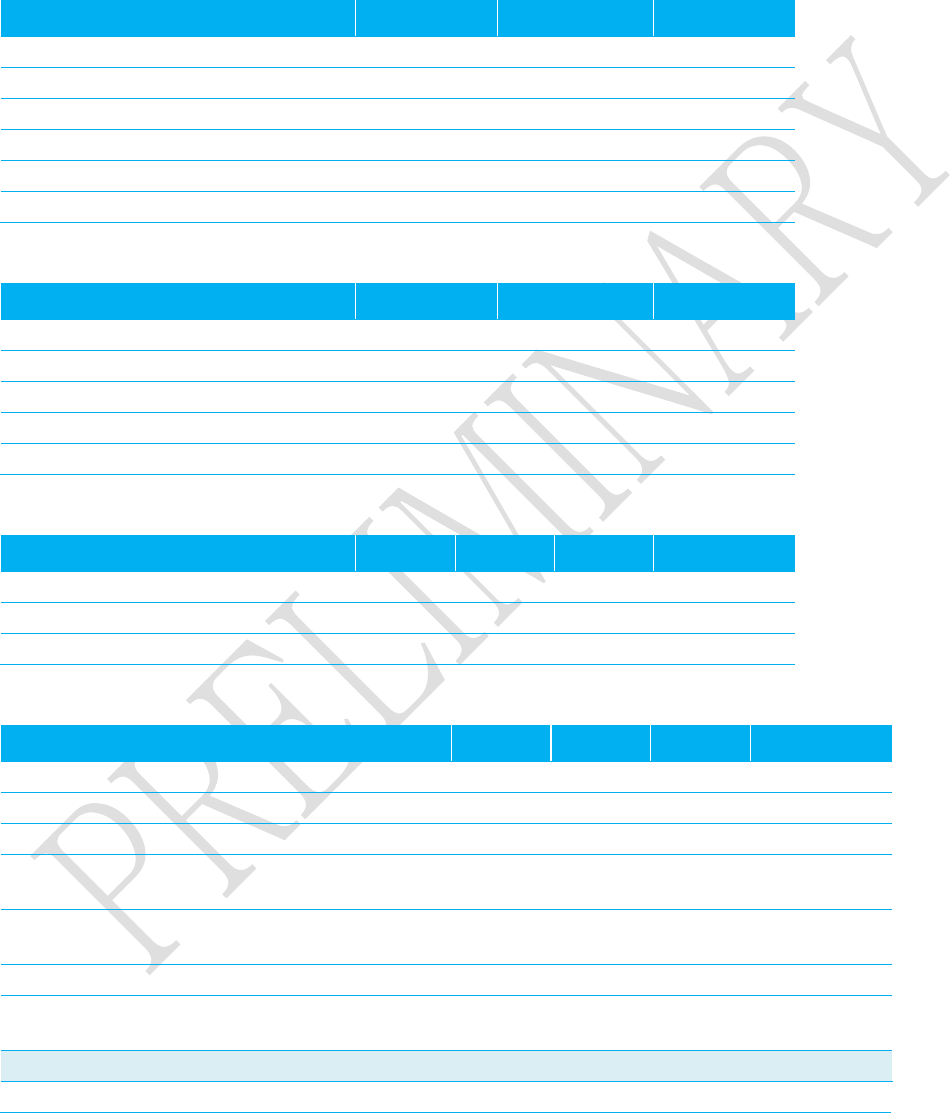
BT800 Hardware Integration Guide
Version 0.2
Americas: +1-800-492-2320 Option 2
Europe: +44-1628-858-940
Hong Kong: +852-2923-0610
www.lairdtech.com/bluetooth
11
CONN-GUIDE-BT800_v0_2
7 DC ELECTRICAL CHARACTERISTIC
Table 1: Absolute maximum ratings
Rating
Min
Max
Unit
Storage temperature
-40
+85
⁰C
VREG_IN_USB
-0.2
5.75
V
VREG_IN_HV
-0.2
4.9
V
VDD_HOST
-0.2
3.7
V
VDD_PADS
-0.2
3.7
V
Other terminal voltages
VSS - 0.4V
VDD + 0.4 V
V
Table 2: Recommended operating conditions
Rating
Min
Max
Unit
Operating temperature
-40
+85
⁰C
VREG_IN_USB
4.5
5.5
V
VREG_IN_HV
3.1
3.6
V
VDD_HOST
3.1
3.6
V
VDD_PADS
1.7
3.6
V
Table 3: USB Linear Regulator
Rating
Min
Typ
Max
Unit
Input voltage (VREG_IN_USB)
4.5
5.0
5.5
V
Output voltage (VREG_IN_HV)
3.2
3.3
3.4
V
Output current
-
-
150
mA
Table 4: High-voltage Linear Regulator
Normal Operation
Min
Typ
Max
Unit
Input voltage (VREG_IN_HV)
3.1
3.3
3.6
V
Output voltage (VREG_OUT_HV)
1.75
1.85
1.95
V
Temperature coefficient
-200
-
200
ppm/⁰C
Output noise (frequency range 100Hz
to100kHz)
-
-
0.4
mV rms
Settling time (settling ti within 10% of
finalvalue)
-
-
5
µs
Output current
-
-
100
mA
Quiescent current (excluding load, Iload
<1mA)
30
40
60
µA
Low-power Mode
Quiescent current
14
18
23
µA
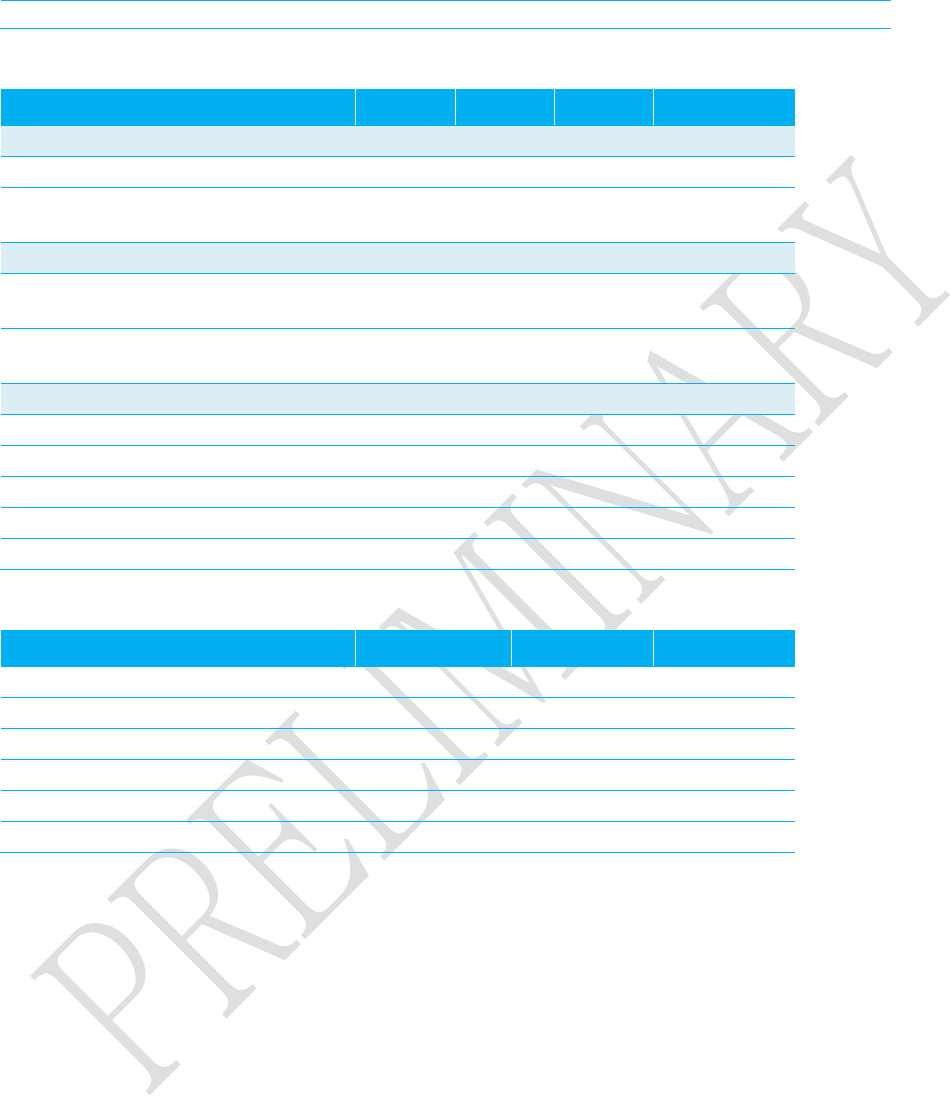
BT800 Hardware Integration Guide
Version 0.2
Americas: +1-800-492-2320 Option 2
Europe: +44-1628-858-940
Hong Kong: +852-2923-0610
www.lairdtech.com/bluetooth
12
CONN-GUIDE-BT800_v0_2
(excluding load, Iload <100µA)
Table 5: Digital I/O Characteristics
Normal Operation
Min
Typ
Max
Unit
Input Voltage
VIL input logic level low
-0.4
-
0.4
V
VIH input logic level high
0.7 x
VDD
-
VDD +
0.4
V
Output Voltage
VOL output logic level low, IOL =
4.0mA
-
-
0.4
V
VOH output logic level high, IOL =
4.0mA
0.75 x
VDD
-
-
V
Input and Tristate Currents
Strong pull-up
-150
-40
-10
µA
Strong pull-down
10
40
150
µA
Weak pull-up
-5
-1.0
-0.33
µA
Weak pull-down
0.33
1.0
5.0
µA
CI input capacitance
1.0
-
5.0
pF
Table 6: Current Consumption
Normal Operation
Peak (8 dBm)
AVG
Unit
Idle
5
mA
USB Suspend
200
µA
Inguiry
73
51
mA
File Transfer
73
58
mA
LE Connected (Master)
74
mA
LE Scan (Master)
48
mA
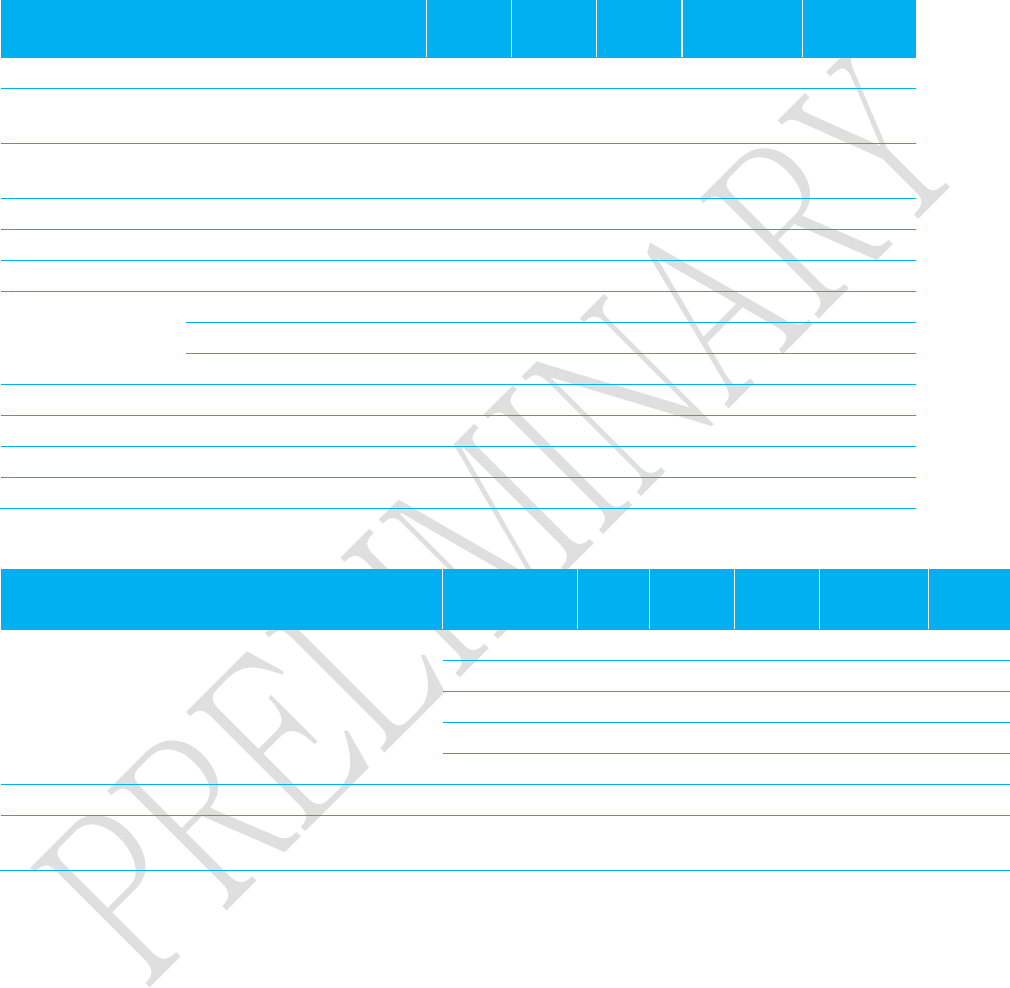
BT800 Hardware Integration Guide
Version 0.2
Americas: +1-800-492-2320 Option 2
Europe: +44-1628-858-940
Hong Kong: +852-2923-0610
www.lairdtech.com/bluetooth
13
CONN-GUIDE-BT800_v0_2
8 RF CHARACTERISTICS
Table 7: Receiver Characteristics
RF Characteristics, VDD = 3.3V @ room
temperature unless otherwise specified
Min
Typ.
Max
BT. Spec.
Unit
Maximum RF Transmit Power
8
10
20
dBm
RF power variation over temperature
range
1.5
-
dB
RF power variation over supply voltage
range
0.2
-
dB
RF power variation over BT band
2
-
dB
RF power control range
-21
8
-
dBm
20 dB band width for modulated carrier
1000
kHz
ACP
F = F0 ± 2MHz
-20
F = F0 ± 3MHz
-40
F = F0 > 3MHz
-40
Drift rate
10
+/-25
kHz
ΔF
1avg
165
140<175
kHz
ΔF1
max
168
140<175
kHz
ΔF2avg / ΔF
1avg
0.9
>=0.8
Table 8: BDR and EDR receiver sensitivity
RF Characteristics, VDD = 3.3V @ room
temp.
Packet
type
Min
Typ
Max
BT. Spec.
Unit
Sensitivity for 0.1% BER
DH1
-89
-70
dBm
DH3
-89
dBm
DH5
-89
dBm
2-DH5
-92
dBm
3-DH5
-85
dBm
Sensitivity variation over BT band
All
2
dB
Sensitivity variation over temperature
range
All
TBD
dB
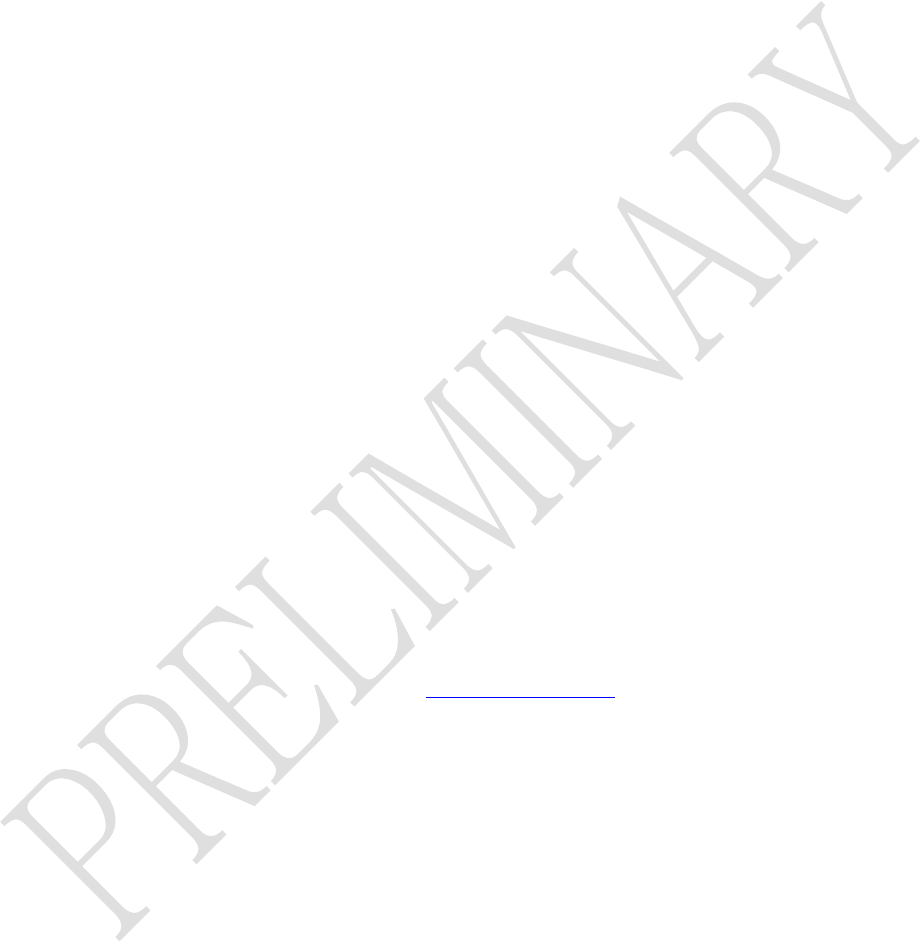
BT800 Hardware Integration Guide
Version 0.2
Americas: +1-800-492-2320 Option 2
Europe: +44-1628-858-940
Hong Kong: +852-2923-0610
www.lairdtech.com/bluetooth
14
CONN-GUIDE-BT800_v0_2
9 INTERFACE
PIO (Programmable I/O Ports) 9.1
See the Device Terminal Functions section for the list of supplies to the PIOs.
PIO lines are configured through software to have either weak or strong pull-ups or pull-downs. All PIO
lines are configured as inputs with weak pull-downs at reset and have additional individual bus keeper
configuration.
WLAN Coexistence Interface 9.2
Dedicated hardware is provided to implement a variety of WLAN coexistence schemes. There is
support for:
Channel skipping AFH
Priority signalling
Channel signalling
Host passing of channel instructions
The BT800 supports the WLAN coexistence schemes:
Unity-3
Unity-3e
Unity+
For more information see Bluetooth and IEEE 802.11 b/g Co-existence Solutions Overview.
USB Interface 9.3
BT800 has a full-speed (12 Mbps) USB interface for communicating with other compatible digital devices.
The USB interface on BT800 acts as a USB peripheral, responding to requests from a master host
controller.
BT800 supports the Universal Serial Bus Specification, Revision v2.0 (USB v2.0 Specification) and USB
Battery Charging Specification, available from http://www.usb.org. For more information on how to
integrate the USB interface on BT800, see the Bluetooth and USB Design Considerations Application
Note.
As well as describing USB basics and architecture, the application note describes:
Power distribution for high and low bus-powered configurations
Power distribution for self-powered configuration, which includes USB VBUS monitoring
USB enumeration
Electrical design guidelines for power supply and data lines, as well as PCB tracks and effects of
ferrite beads
USB suspend modes and Bluetooth low-power modes:
Global suspend
Selective suspend, includes remote wake
Wake on Bluetooth, includes permitted devices and set-up prior to selective suspend
Suspend mode current draw
PIO status in suspend mode
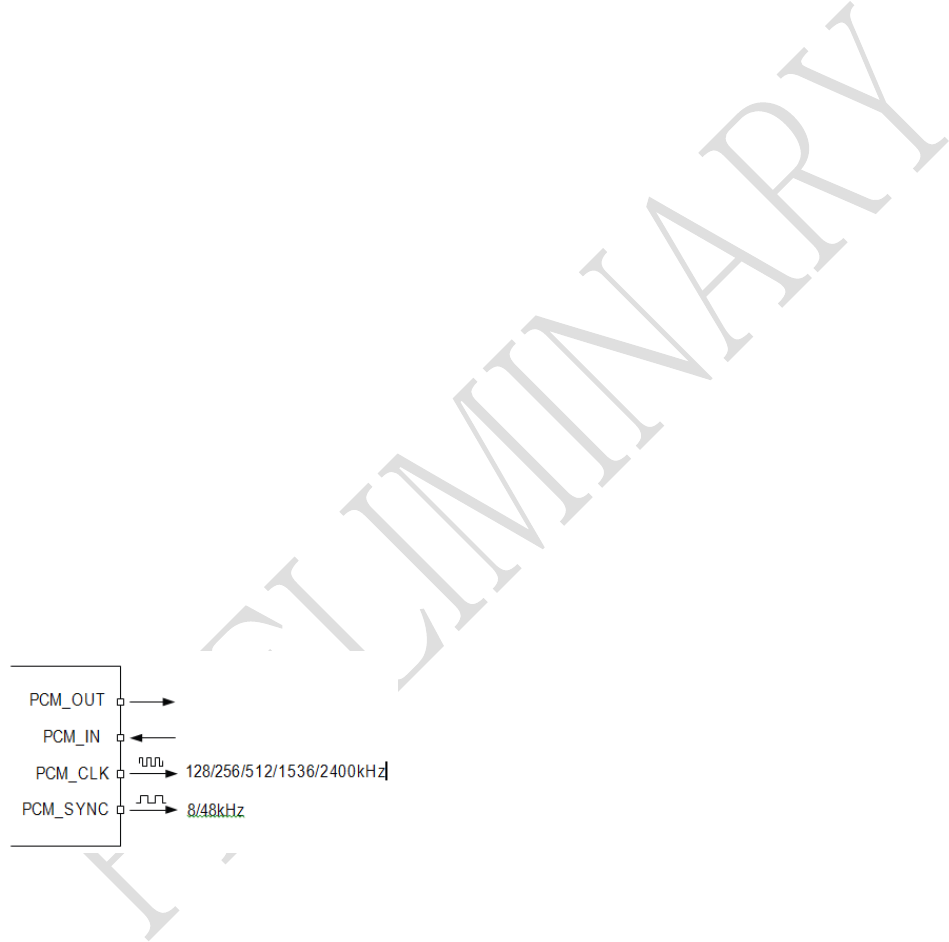
BT800 Hardware Integration Guide
Version 0.2
Americas: +1-800-492-2320 Option 2
Europe: +44-1628-858-940
Hong Kong: +852-2923-0610
www.lairdtech.com/bluetooth
15
CONN-GUIDE-BT800_v0_2
Resume, detach and wake PIOs
Battery charging from USB: dead battery provision, charge currents, charging in suspend modes
and USB
VBUS voltage consideration
USB termination when interface is not in use
internal modules, certification and non-specification compliant operation
PCM Interface 9.4
The audio PCM interface on the BT800 supports:
Continuous transmission and reception of PCM encoded audio data over Bluetooth.
Processor overhead reduction through hardware support for continual transmission and reception
of PCM data.
A bidirectional digital audio interface that routes directly into the baseband layer of the firmware.
It does not pass through the HCI protocol layer.
Hardware on BT800for sending data to and from a SCO connection.
Up to 3 SCO connections on the PCM interface at any one time.
PCM interface master, generating PCM_SYNC and PCM_CLK.
PCM interface slave, accepting externally generated PCM_SYNC and PCM_CLK.
Various clock formats including:
Long Frame Sync
Short Frame Sync
GCI timing environments
13-bit or 16-bit linear, 8-bit µ-law or A-law companded sample formats.
Receives and transmits on any selection of 3 of the first 4 slots following PCM_SYNC.
The PCM configuration options are enabled by setting PSKEY_PCM_CONFIG32.
9.4.1 PCM Interface Master/Slave
When configured as the master of the PCM interface, BT800generates PCM_CLK and PCM_SYNC.
Figure 2: PCM Interface Master
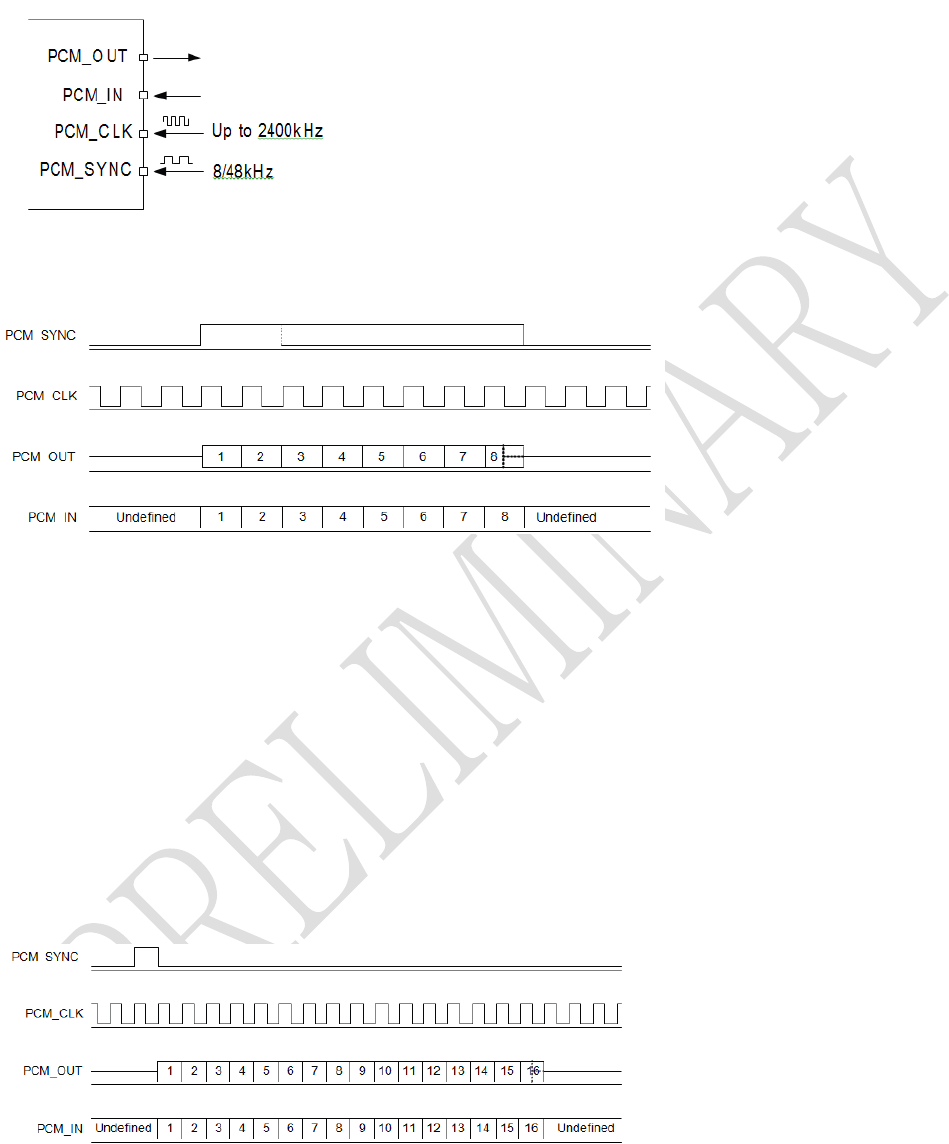
BT800 Hardware Integration Guide
Version 0.2
Americas: +1-800-492-2320 Option 2
Europe: +44-1628-858-940
Hong Kong: +852-2923-0610
www.lairdtech.com/bluetooth
16
CONN-GUIDE-BT800_v0_2
Figure 3: PCM Interface Slave
9.4.2
L
ong
Frame
Sync
Figure 4: Long Frame Sync (Shown with 8-bit Companded Sample)
Long Frame Sync is the name given to a clocking format that controls the transfer of PCM data words or
samples. In Long Frame Sync, the rising edge of PCM_SYNC indicates the start of the PCM word. When
BT800 is configured as PCM master, generating PCM_SYNC and PCM_CLK, then PCM_SYNC is 8 bits long.
When BT800 is configured as PCM Slave, PCM_SYNC is from 1 cycle PCM_CLK to half the PCM_SYNC
rate.
BT800 samples PCM_IN on the falling edge of PCM_CLK and transmits PCM_OUT on the rising edge.
PCM_OUT is configurable as high impedance on the falling edge of PCM_CLK in the LSB position or on
the rising edge.
9.4.3
S
hort
Frame
S
y
nc
In Short Frame Sync, the falling edge of PCM_SYNC indicates the start of the PCM word. PCM_SYNC is
always 1 clock cycle long.
Figure 5: Short Frame Sync (Shown with 16-bit Sample)
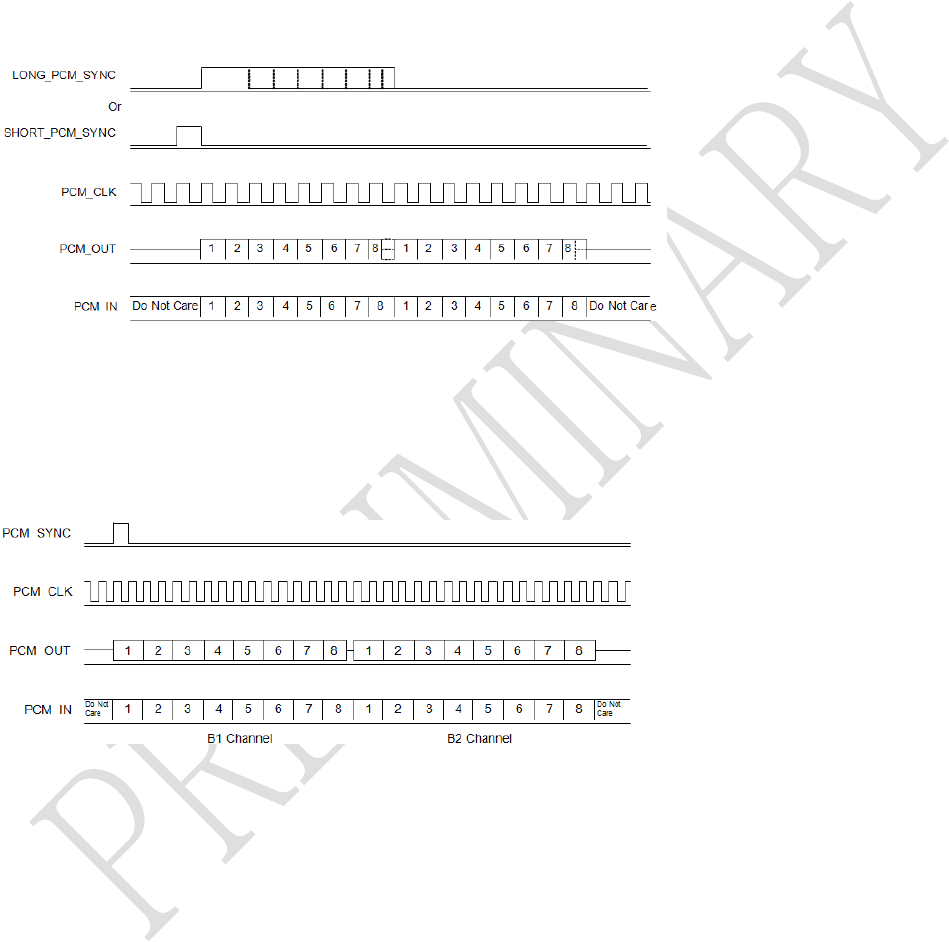
BT800 Hardware Integration Guide
Version 0.2
Americas: +1-800-492-2320 Option 2
Europe: +44-1628-858-940
Hong Kong: +852-2923-0610
www.lairdtech.com/bluetooth
17
CONN-GUIDE-BT800_v0_2
As with Long Frame Sync, BT800 samples PCM_IN on the falling edge of PCM_CLK and transmits
PCM_OUT on the rising edge. PCM_OUT is configurable as high impedance on the falling edge of
PCM_CLK in the LSB position or on the rising edge.
9.4.4 Multi-slot Operation
More than 1 SCO connection over the PCM interface is supported using multiple slots. Up to 3 SCO
connections are carried over any of the first 4 slots.
Figure 6: Multi-slot Operation with 2 Slots and 8-bit Companded Samples
GCI Interface 9.5
BT800 is compatible with the GCI, a standard synchronous 2B+D ISDN timing interface. The two 64 kbps B
channels are accessed when this mode is configured.
Figure 7: Multi-slot Operation
The start of frame is indicated by the rising edge of PCM_SYNC and runs at 8kHz.
Slots and Sample Formats 9.6
BT800 receives and transmits on any selection of the first 4 slots following each sync pulse. Slot durations
are either 8 or 16 clock cycles:
8 clock cycles for 8-bit sample formats.
16 clock cycles for 8-bit, 13-bit or 16-bit sample formats.
BT800 supports:
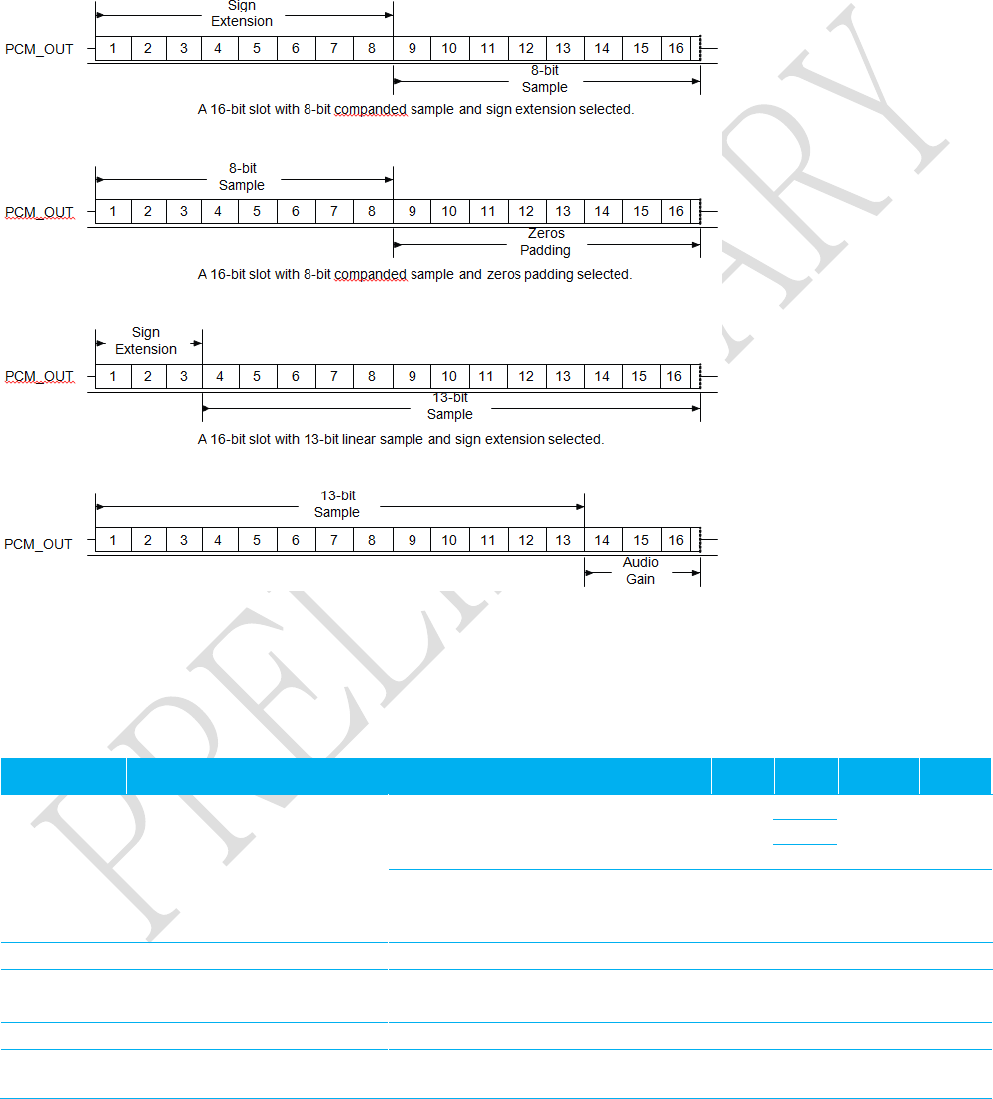
BT800 Hardware Integration Guide
Version 0.2
Americas: +1-800-492-2320 Option 2
Europe: +44-1628-858-940
Hong Kong: +852-2923-0610
www.lairdtech.com/bluetooth
18
CONN-GUIDE-BT800_v0_2
13-bit linear, 16-bit linear and 8-bit µ-law or A-law sample formats.
A sample rate of 8ksps.
Little or big endian bit order.
For 16-bit slots, the 3 or 8 unused bits in each slot are filled with sign extension, padded with zeros
or a programmable 3-bit audio attenuation compatible with some codecs.
Figure 8: 16-bit Slot Length and Sample Formats
PCM Timing Information
9.7
Table 9: PCM Timing information.
Symbol
Parameter
Min
Typ
Max
Unit
fmclk
PCM_CLK frequency
4MHz DDS generation.
Frequency selection is
programmable.
-
128
-
kHz
256
512
48MHz DDS generation.
Frequency selection is
programmable.
2.9
-
-
kHz
-
PCM_SYNC frequency for SCO connection
-
8
-
kHz
tmclkh
(a)
PCM_CLK high
4MHz DDS generation
980
-
-
ns
tmclkl a)
PCM_CLK low
4MHz DDS generation
730
-
-
ns
-
PCM_CLK jitter
48MHz DDS generation
-
-
21
ns
pk-p
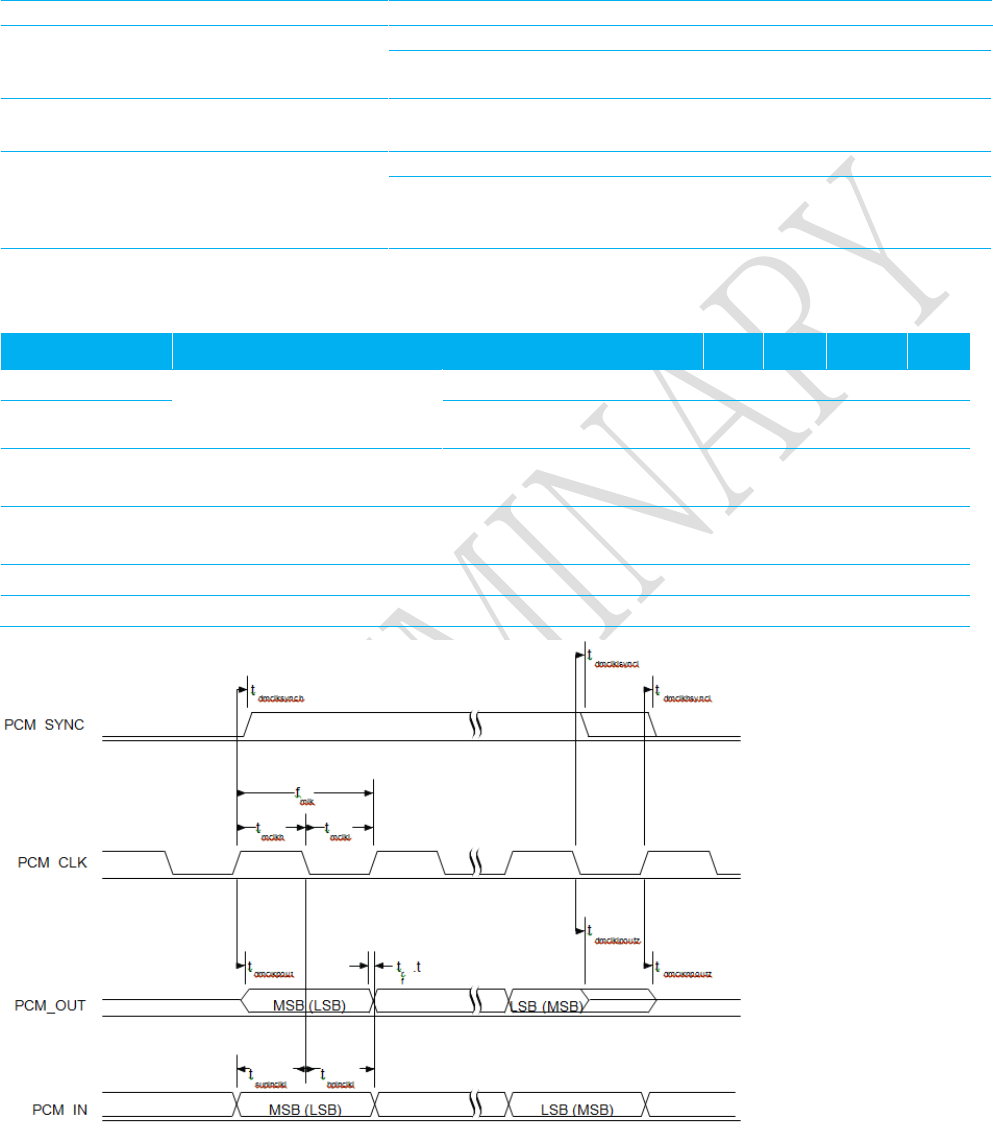
BT800 Hardware Integration Guide
Version 0.2
Americas: +1-800-492-2320 Option 2
Europe: +44-1628-858-940
Hong Kong: +852-2923-0610
www.lairdtech.com/bluetooth
19
CONN-GUIDE-BT800_v0_2
k
tdmclksy
nch
Delay time from
PCM_CLK high to
PCM_SYNC high
4MHz DDS generation
-
-
20
ns
48MHz DDS generation
-
-
40.83
ns
tdmclkpo
ut
Delay time from PCM_CLK high to valid PCM_OUT
-
-
20
ns
tdmclklsy
ncl
Delay time from
PCM_CLK low to
PCM_SYNC low (long
frame sync only)
4MHz DDS generation
-
-
20
ns
48MHz DDS generation
-
-
40.83
ns
(a) Assumes normal system clock operation. Figures vary during low-power modes, when system clock speeds are reduced.
Table 10: PCM Master Mode Timing Parameters
Symbol
Parameter
Min
Typ
Max
Unit
tdmclkhsyncl
Delay time from
PCM_CLK high to
PCM_SYNC low
4MHz DDS generation
-
-
20
ns
48MHz DDS generation
-
-
40.83
ns
tdmclklpoutz
Delay time from PCM_CLK low to PCM_OUT
high impedance
-
-
20
ns
tdmclkhpout
z
Delay time from PCM_CLK high to PCM_OUT
high impedance
-
-
20
ns
tsupinclkl
Set-up time for PCM_IN valid to PCM_CLK low
20
-
-
ns
thpinclkl
Hold time for PCM_CLK low to PCM_IN invalid
0
-
-
ns
Figure 9: PCM Master Timing Long Frame Sync
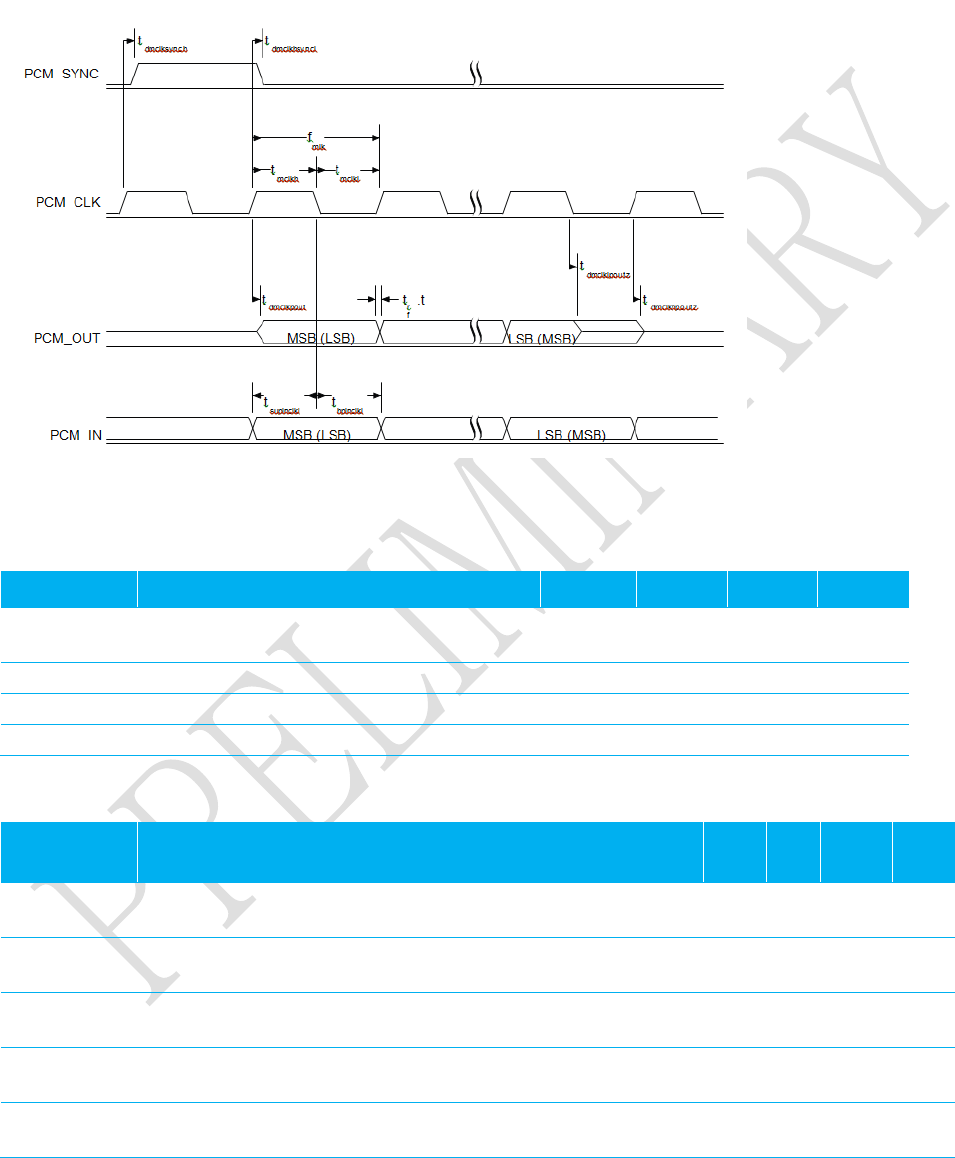
BT800 Hardware Integration Guide
Version 0.2
Americas: +1-800-492-2320 Option 2
Europe: +44-1628-858-940
Hong Kong: +852-2923-0610
www.lairdtech.com/bluetooth
20
CONN-GUIDE-BT800_v0_2
Figure 10: PCM Master Timing Short Frame Sync
PCM Slave Timing 9.8
Symbol
Parameter
Min
Typ
Max
Unit
fsclk
PCM clock frequency (Slave mode:
input)
64
-
2048
kHz
fsclk
PCM clock frequency (GCI mode)
128
-
4096
kHz
tsclkl
PCM_CLK low time
200
-
-
ns
tsclkh
PCM_CLK high time
200
-
-
ns
PCM Slave Mode Timing Parameters 9.9
Symbol
Parameter
Min
Ty
p
Max
Unit
thsclksync
h
Hold time from PCM_CLK low to PCM_SYNC high
2
-
-
ns
tsusclksyn
ch
Set-up time for PCM_SYNC high to PCM_CLK low
20
-
-
ns
tdpout
Delay time from PCM_SYNC or PCM_CLK, whichever is
later, to valid PCM_OUT data (long frame sync only)
-
-
15
ns
tdsclkhpo
ut
Delay time from CLK high to PCM_OUT valid data
-
-
15
ns
tdpoutz
Delay time from PCM_SYNC or PCM_CLK low, whichever
is later, to PCM_OUT data line high impedance
-
-
20
ns
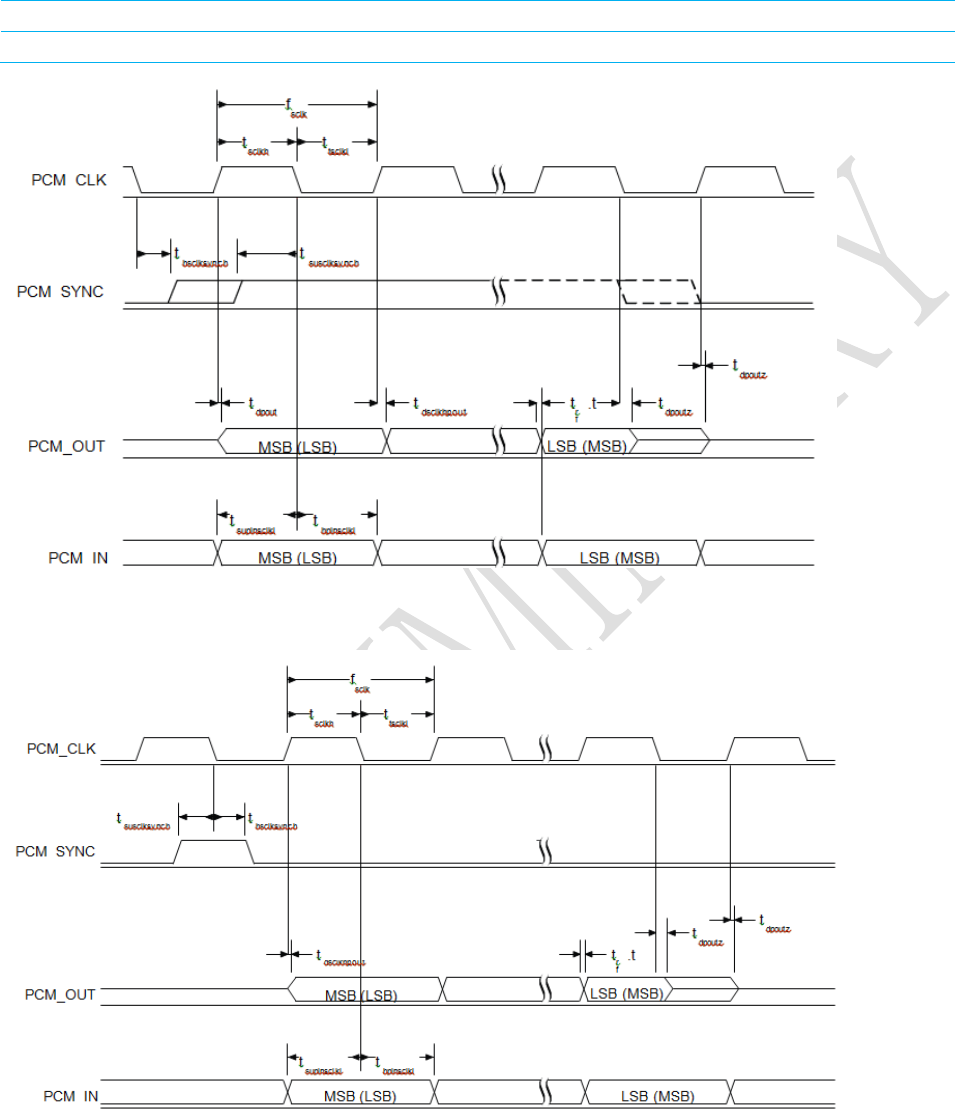
BT800 Hardware Integration Guide
Version 0.2
Americas: +1-800-492-2320 Option 2
Europe: +44-1628-858-940
Hong Kong: +852-2923-0610
www.lairdtech.com/bluetooth
21
CONN-GUIDE-BT800_v0_2
tsupinsclkl
Set-up time for PCM_IN valid to CLK low
20
-
-
ns
thpinsclkl
Hold time for PCM_CLK low to PCM_IN invalid
2
-
-
ns
Figure 11: PCM Slave Timing Long Frame Sync
Figure 12: PCM Slave Timing Short Frame Sync
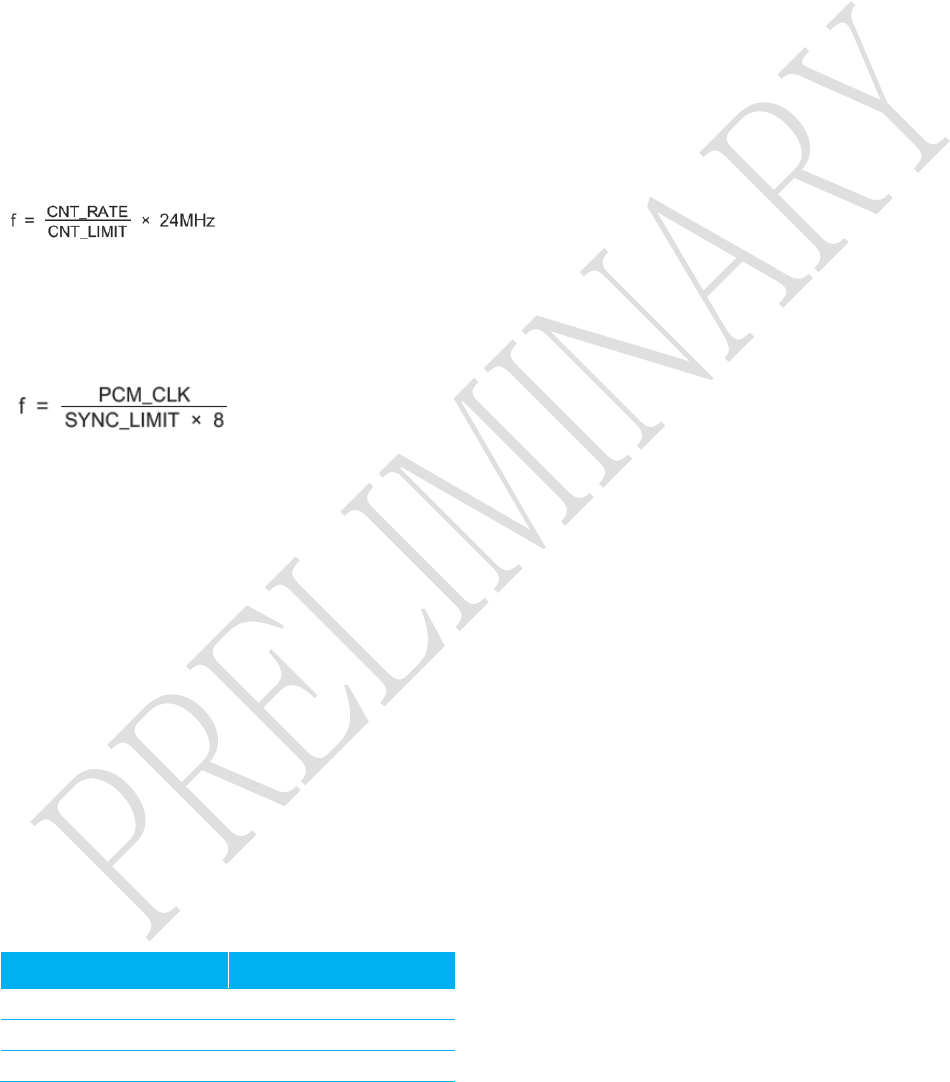
BT800 Hardware Integration Guide
Version 0.2
Americas: +1-800-492-2320 Option 2
Europe: +44-1628-858-940
Hong Kong: +852-2923-0610
www.lairdtech.com/bluetooth
22
CONN-GUIDE-BT800_v0_2
PCM_CLK and PCM_SYNC Generation
9.10
BT800 has 2 methods of generating PCM_CLK and PCM_SYNC in master mode:
Generating these signals by DDS from BT800internal 4MHz clock. Using this mode limits PCM_CLK to
128, 256 or 512kHz and PCM_SYNC to 8kHz.
Generating these signals by DDS from an internal 48MHz clock, which enables a greater range of
frequencies to be generated with low jitter but consumes more power. To select this second
method set bit 48M_PCM_CLK_GEN_EN in PSKEY_PCM_CONFIG32. When in this mode and with
long frame sync, the length of PCM_SYNC is either 8 or 16 cycles of PCM_CLK, determined by
LONG_LENGTH_SYNC_EN in PSKEY_PCM_CONFIG32.
Equation 9.1 describes PCM_CLK frequency when generated from the internal 48MHz clock:
Equation 9.1: PCM_CLK Frequency Generated Using the Internal 48MHz Clock
Set the frequency of PCM_SYNC relative to PCM_CLK using Equation 9.2:
Equation 9.2: PCM_SYNC Frequency Relative to PCM_CLK
CNT_RATE, CNT_LIMIT and SYNC_LIMIT are set using PSKEY_PCM_LOW_JITTER_CONFIG. As an example, to
generate PCM_CLK at 512kHz with PCM_SYNC at 8kHz, set SKEY_PCM_LOW_JITTER_CONFIG to
0x08080177.
PCM Configuration 9.11
Configure the PCM by using PSKEY_PCM_CONFIG32 and PSKEY_PCM_LOW_JITTER_CONFIG, see your
PSKey file. The default for PSKEY_PCM_CONFIG32 is 0x00800000, i.e. first slot following sync is active,
13-bit linear voice format, long frame sync and interface master generating 256kHz PCM_CLK from
4MHz internal clock with no tri-state of PCM_OUT.
Digital Audio Interface (I²S) 9.12
The digital audio interface supports the industry standard formats for I²S, left-justified or right-justified. The
interface shares the same pins as the PCM interface, which means each audio bus is mutually exclusive
in its usage. Table 11 lists these alternative functions. Fig.13 shows the timing diagram.
Table 11: Alternative Functions of the Digital Audio Bus Interface on the PCM Interface.
PCM
Interface
I
²
S
Interface
PCM_OUT
SD_OUT
PCM_IN
SD_IN
PCM_SYNC
WS
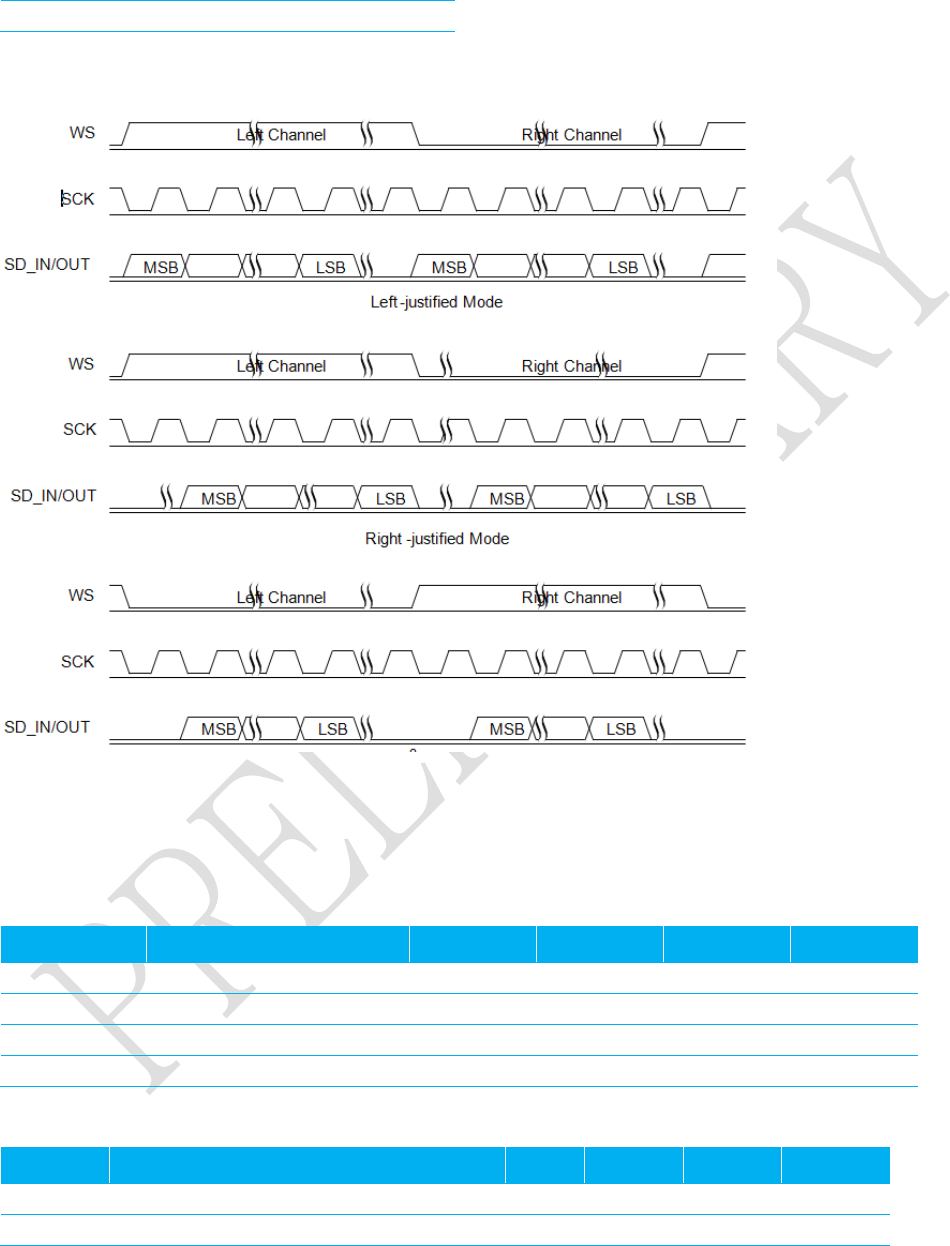
BT800 Hardware Integration Guide
Version 0.2
Americas: +1-800-492-2320 Option 2
Europe: +44-1628-858-940
Hong Kong: +852-2923-0610
www.lairdtech.com/bluetooth
23
CONN-GUIDE-BT800_v0_2
PCM_CLK
SCK
Configure the digital audio interface using PSKEY_DIGITAL_AUDIO_CONFIG, see BlueCore Audio API
Specification and the PS Key file.
Figure 13: PCM Configuration
The internal representation of audio samples within BT800is 16-bit and data on SD_OUT is limited to 16-bit
per channel.
Table 12: Digital Audio Interface Slave Timing
Symbol
Parameter
Min
Typ
Max
Unit
-
SCK Frequency
-
-
6.2
MHz
-
WS Frequency
-
-
96
kHz
tch
SCK high time
80
-
-
ns
tcl
SCK low time
80
-
-
ns
Table 13: I²S Slave Mode Timing
Symbol
Parameter
Min
Typ
Max
Unit
tssu
WS valid to SCK high set-up time
20
-
-
ns
tsh
SCK high to WS invalid hold time
2.5
-
-
ns
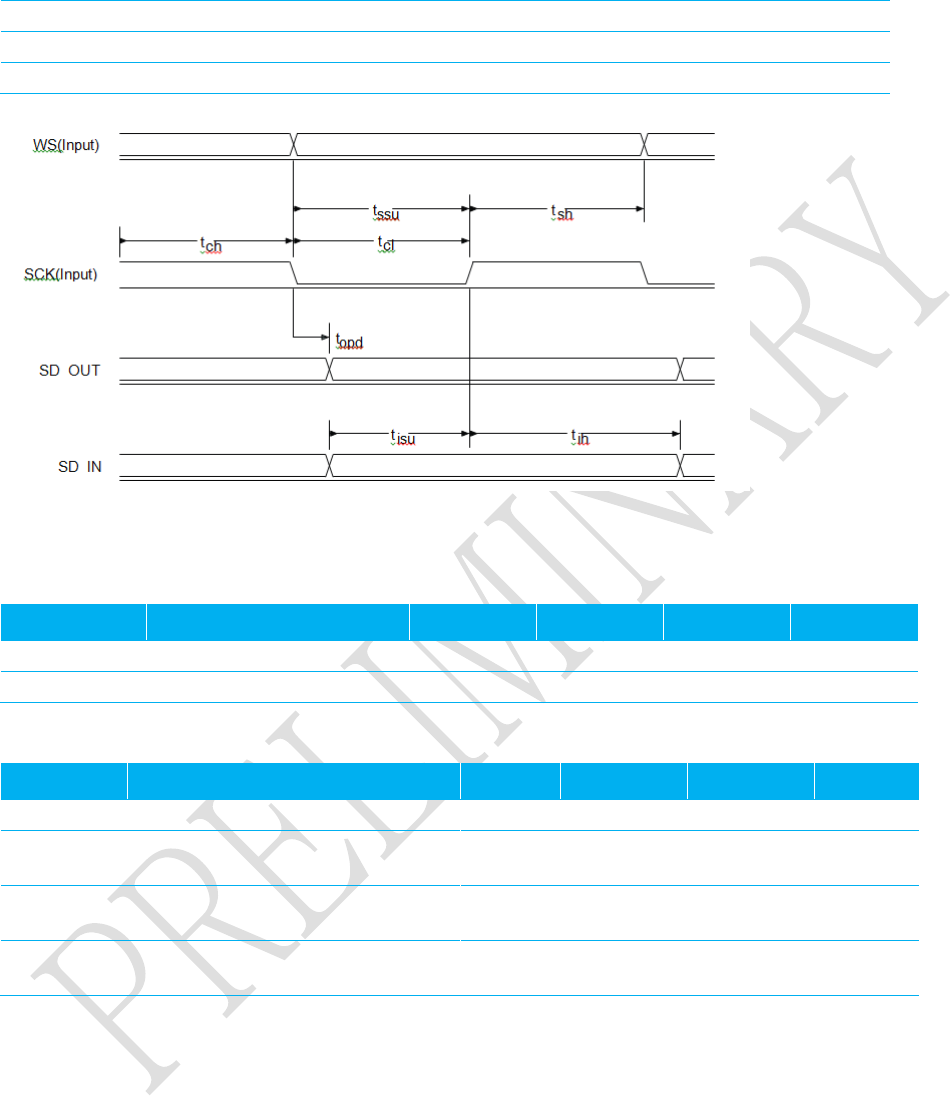
BT800 Hardware Integration Guide
Version 0.2
Americas: +1-800-492-2320 Option 2
Europe: +44-1628-858-940
Hong Kong: +852-2923-0610
www.lairdtech.com/bluetooth
24
CONN-GUIDE-BT800_v0_2
topd
SCK low to SD_OUT valid delay time
-
-
20
ns
tisu
SD_IN valid to SCK high set-up time
20
-
-
ns
tih
SCK high to SD_IN invalid hold time
2.5
-
-
ns
Figure 14: Digital Audio Interface Slave Timing
Table 14: Digital Audio Interface Master Timing
Symbol
Parameter
Min
Typ
Max
Unit
-
SCK Frequency
-
-
6.2
MHz
-
WS Frequency
-
-
96
kHz
Table 15: I²S Master Mode Timing Parameters, WS and SCK as Outputs
Symbol
Parameter
Min
Typ
Max
Unit
tspd
SCK low to WS valid delay time
-
-
39.27
ns
topd
SCK low to SD_OUT valid delay
time
-
-
18.44
ns
tisu
SD_IN valid to SCK high set-up
time
18.44
-
-
ns
tih
SCK high to SD_IN invalid hold
time
0
-
-
ns
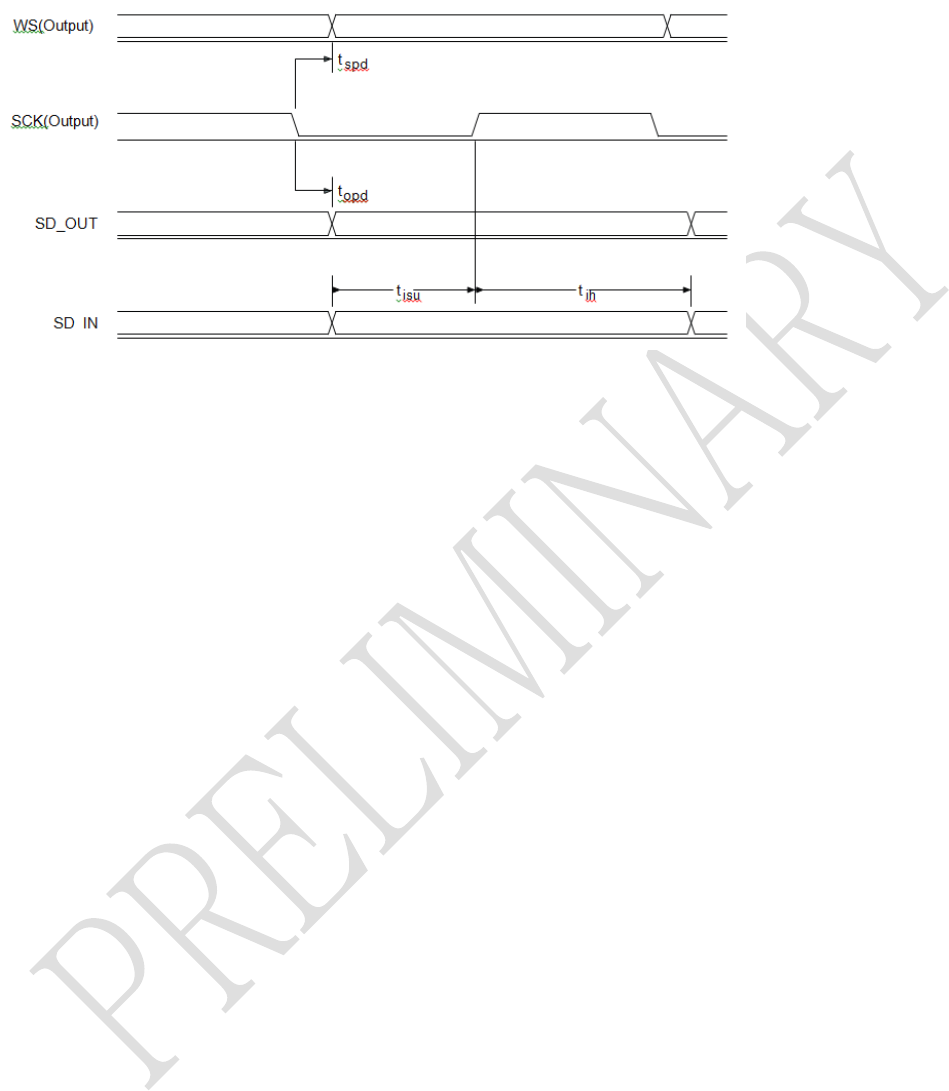
BT800 Hardware Integration Guide
Version 0.2
Americas: +1-800-492-2320 Option 2
Europe: +44-1628-858-940
Hong Kong: +852-2923-0610
www.lairdtech.com/bluetooth
25
CONN-GUIDE-BT800_v0_2
Figure 15: Digital Audio Interface Master Timing
10 POWER CONTROL AND REGULATION
See the Example Application Schematic for the regulator configuration. BT800 contains 5 regulators:
USB linear regulator, to generate the 3.3 V for the USB interface and the input to the high-voltage
linear regulator.
High-voltage linear regulator, to generate the main 1.8V from the USB linear regulator or an
external 3.3V.
This regulator then feeds the 3 low-voltage regulators:
Low-voltage VDD_DIG linear regulator, a programmable low-voltage regulator to supply a 0.90V
to1.25V digital supply, VDD_DIG.
Low-voltage VDD_ANA linear regulator, to supply the radio supply, VDD_RADIO.
Low-voltage VDD_AUX linear regulator, to supply the auxiliary supply, VDD_AUX.
USB Linear Regulator 10.1
The integrated USB LDO linear regulator is available as a 3.30V supply rail and is intended to supply the
USB interface and the high-voltage linear regulator. The input voltage range is between 4.25V and
5.75V. The maximum current from this regulator is 150mA, of which 50mA is available for external use, for
example EEPROM/LED. Externally decouple the output of this regulator using a low ESR MLC capacitor
to the VREG_IN_HV pin. The regulator operates correctly with an output capacitor of 1µF to 4.7µF
(±20%).
This regulator is enabled by default. If the USB linear regulator is not required, leave its input
(VREG_IN_USB) unconnected.
High-voltage Linear Regulator
10.2
The integrated high-voltage linear regulator is available to power the main 1.8 V supply rail. The input
voltage range is between 2.3 V and 4.8 V. The maximum current from this regulator is 100 mA. Externally
decouple the output of this regulator using a low ESR MLC capacitor of a minimum 1.5 µF to the
VREG_OUT_HV pin. Take VREG_EN_RST# high to enable this regulator. If this regulator is not required then
leave VREG_IN_HV unconnected or tied to VREG_OUT_HV.
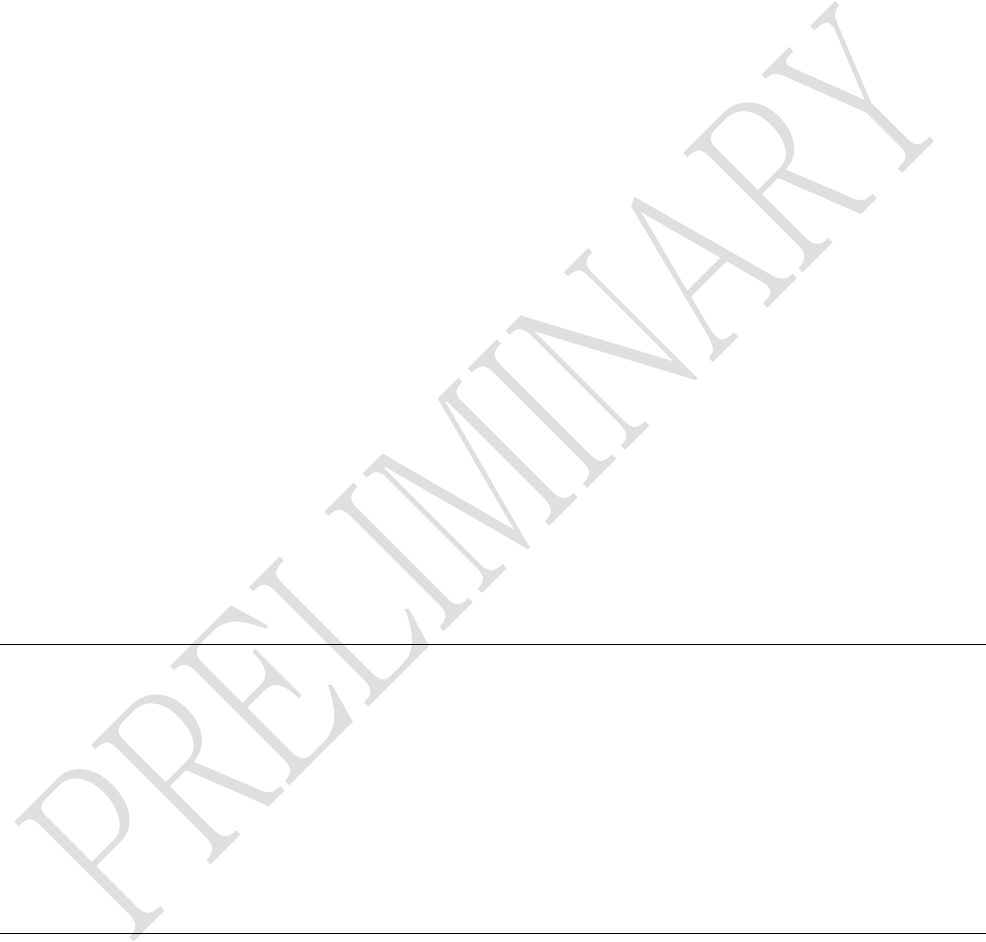
BT800 Hardware Integration Guide
Version 0.2
Americas: +1-800-492-2320 Option 2
Europe: +44-1628-858-940
Hong Kong: +852-2923-0610
www.lairdtech.com/bluetooth
26
CONN-GUIDE-BT800_v0_2
Low-voltage VDD_DIG Linear Regulator
10.3
The integrated low-voltage VDD_DIG linear regulator is available to power a 0.90 V to 1.25 V supply rail
which includes the digital circuits on CSR8510 WLCSP. The input voltage range is between 1.70 V and
1.95 V.
Externally decouple the output of this regulator using a low ESR MLC capacitor of a minimum 1.5µF to
the VDD_DIG pin. Software enables and controls the output voltage.
Low-voltage VDD_RADIO Linear Regulator 10.4
The integrated low-voltage VDD_RADIO linear regulator is available to power a 1.35 V analogue supply
rail which includes the radio circuits on CSR8510 WLCSP. The input voltage range is between 1.70 V and
1.95 V. Externally decouple the output of this regulator using a low ESR MLC capacitor of a minimum 1.5
µF to the VDD_RADIO pin. Software enables and controls the output voltage. The regulator is disabled
when BT800is in deep sleep or reset.
Low-voltage VDD_AUX Linear Regulator 10.5
The integrated low-voltage VDD_AUX linear regulator is available to power a 1.35V auxiliary supply rail
which includes the VDD_AUX supply on CSR8510 WLCSP. The input voltage range is between 1.70V and
1.95V.
Externally decouple the output of this regulator using a low ESR MLC capacitor of a minimum 470nF to
the VDD_AUX pin. Take VREG_EN_RST# high to enable this regulator. Software controls the output
voltage.
Voltage Regulator Enable and Reset 10.6
A single pin VREG_EN_RST# controls both the regulator enables and the digital reset function. All the
regulators are enabled, except the USB linear regulator, by taking the VREG_EN_RST# pin above 1V.
Software also controls the regulators. The VREG_EN_RST# pin is connected internally to the reset
function and is powered from VDD_HOST, so do not apply voltages above VDD_HOST to the
VREG_EN_RST# pin. The REG_EN_RST# pin is pulled down internally before the software starts. The
VREG_EN_RST# pin is an active low reset. Assert the reset signal for a period >5ms to ensure a full reset.
Note: The regulator enables are released as soon as VREG_EN_RST# is low, so the regulators shut
down. Therefore do not take VREG_EN_RST# low for less than 5ms, as a full reset is not
guaranteed.
Other reset sources are:
Power-on reset
Via a software-configured watchdog timer
A warm reset function is also available under software control. After a warm reset the RAM
data remains available.
Power Sequencing 10.7
CSR recommends that the power supplies are all powered at the same time. The order of powering the
supplies relative to the I/O supply, VDD_PADS to VDD_HOST, is not important. If the I/O supply is powered
before VDD_DIG, all digital I/Os are weak pull-downs irrespective of the reset state.
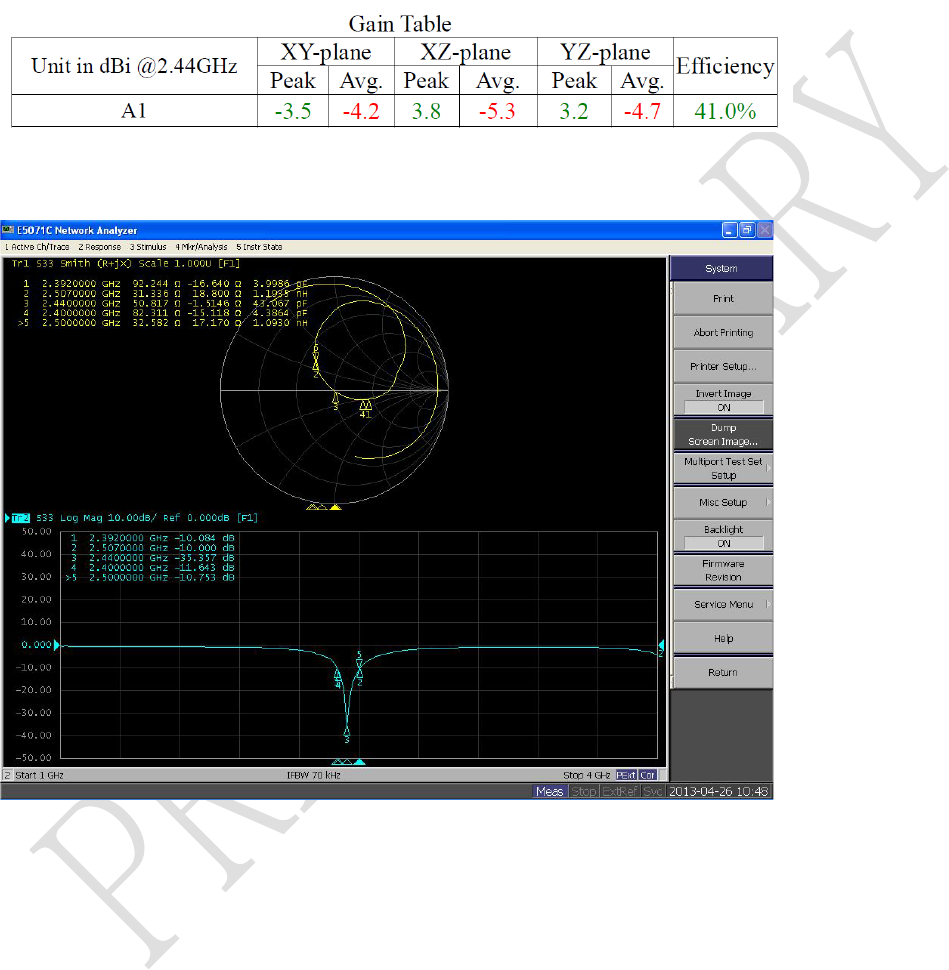
BT800 Hardware Integration Guide
Version 0.2
Americas: +1-800-492-2320 Option 2
Europe: +44-1628-858-940
Hong Kong: +852-2923-0610
www.lairdtech.com/bluetooth
27
CONN-GUIDE-BT800_v0_2
11 ANTENNA PERFORMANCE
The following diagrams illustrate antenna performance.
Figure 16: BT800 Gain Table
Figure 17: Network Analyzer output
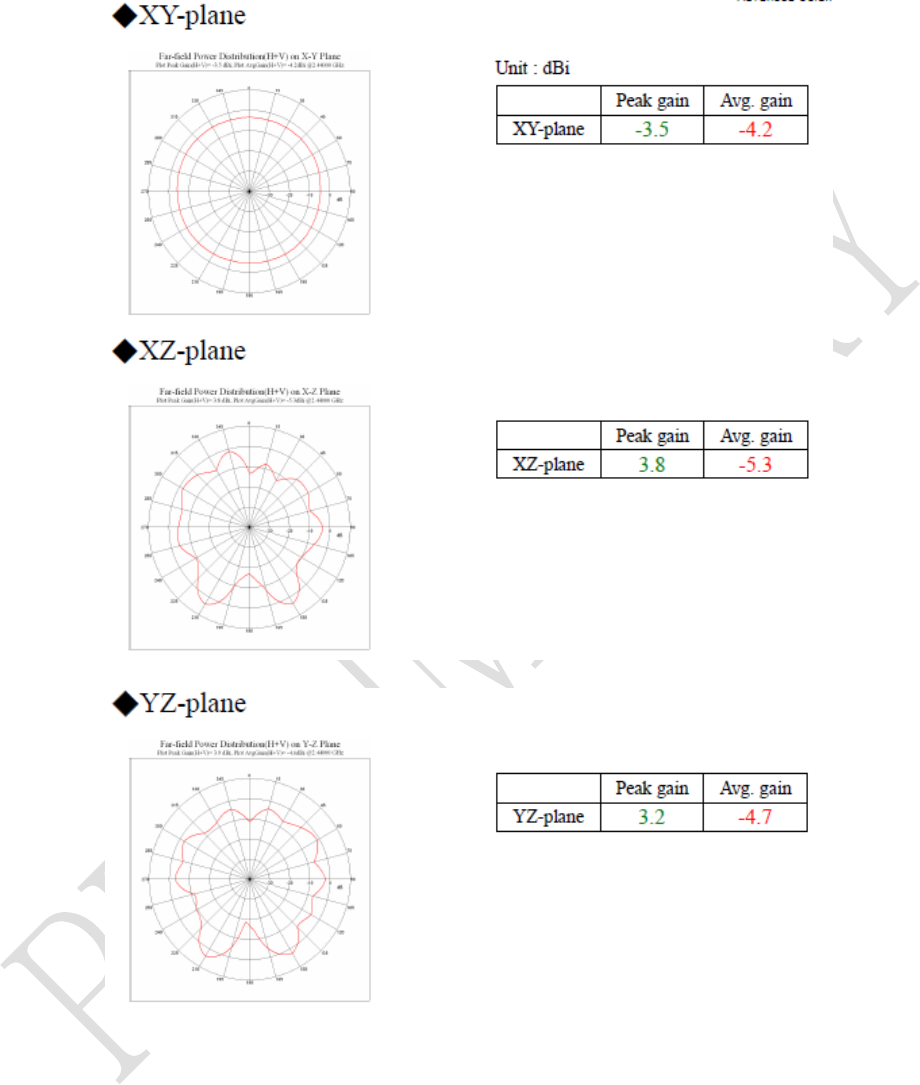
BT800 Hardware Integration Guide
Version 0.2
Americas: +1-800-492-2320 Option 2
Europe: +44-1628-858-940
Hong Kong: +852-2923-0610
www.lairdtech.com/bluetooth
28
CONN-GUIDE-BT800_v0_2
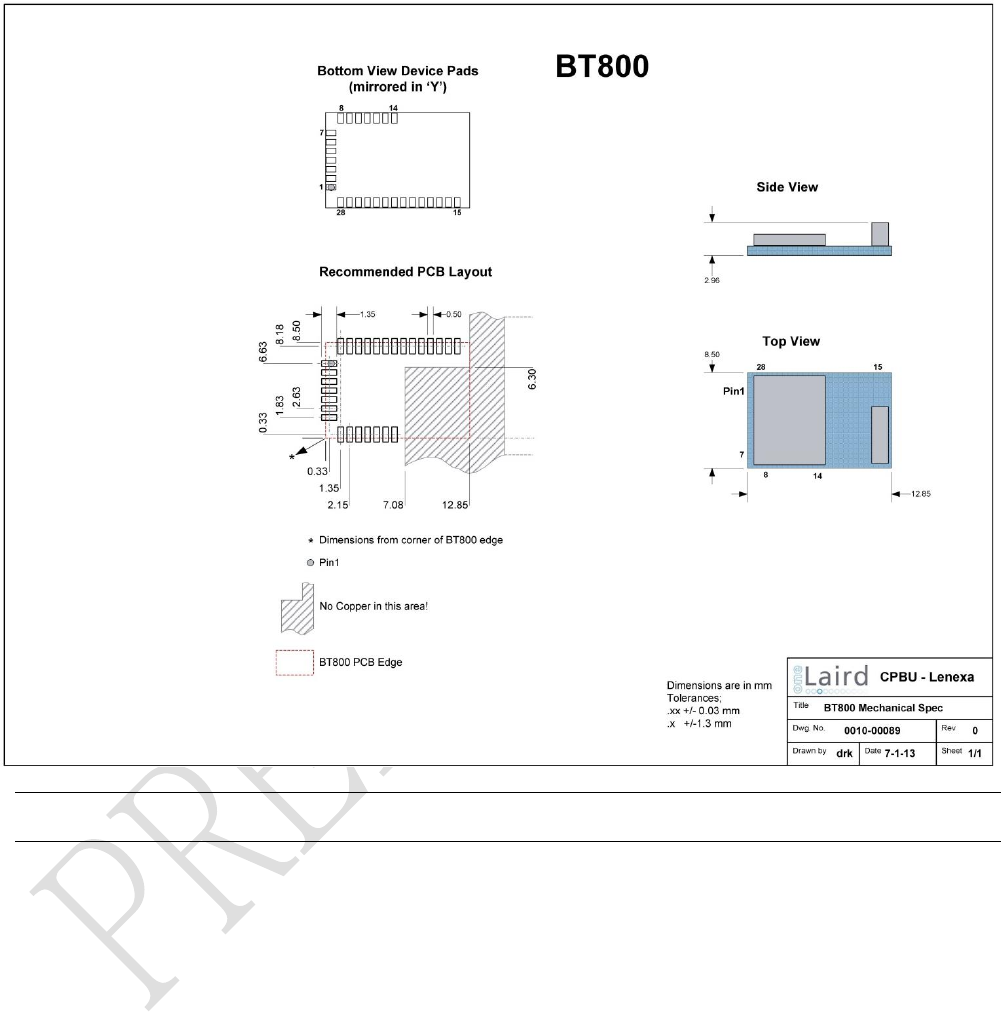
BT800 Hardware Integration Guide
Version 0.2
Americas: +1-800-492-2320 Option 2
Europe: +44-1628-858-940
Hong Kong: +852-2923-0610
www.lairdtech.com/bluetooth
29
CONN-GUIDE-BT800_v0_2
12 MECHANICAL DIMENSIONS AND LAND PATTERN
Note: Dimensions are in mm.
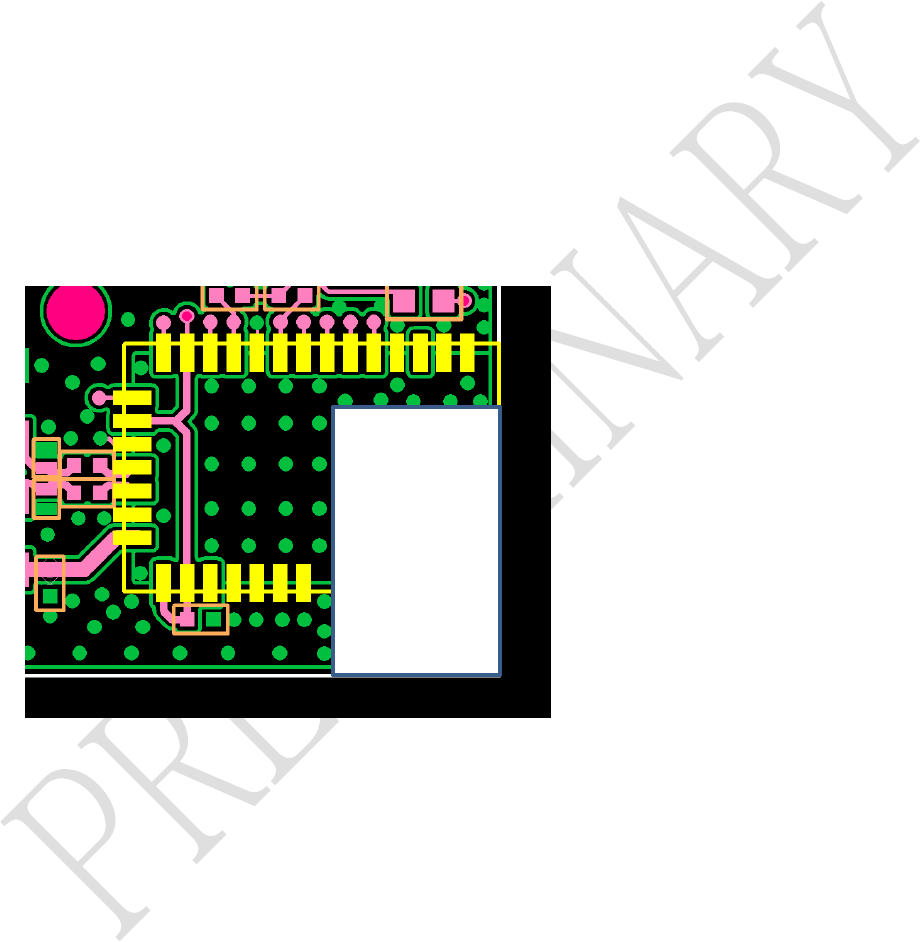
BT800 Hardware Integration Guide
Version 0.2
Americas: +1-800-492-2320 Option 2
Europe: +44-1628-858-940
Hong Kong: +852-2923-0610
www.lairdtech.com/bluetooth
30
CONN-GUIDE-BT800_v0_2
13 IMPLEMENTATION NOTE
PCB Layout on Host PCB 13.1
Checklist (for PCB):
MUST locate BT800/BT810 module close to the edge of PCB.
Use solid GND plane on inner layer (for best EMC and RF performance).
Place GND vias close to module GND pads as possible
Route traces to avoid noise being picked up on VCC supply.
Antenna Keep-out area:
- Ensure there is no copper in the antenna keep-out area on any layers of the host PCB.
- Keep all mounting hardware and metal clear of the area to allow proper antenna radiation.
- For best antenna performance, place the BT800 module on the edge of the host PCB,
preferably in the corner with the antenna facing the corner.
- A different host PCB thickness dielectric will have small effect on antenna.
Figure 18: Recommend Antenna keep-out area (in White) used on the BT800
13.1.1 Antenna keep-out and Proximity to Metal or Plastic
Checklist (for metal /plastic enclosure):
Minimum safe distance for metals without seriously compromising the antenna (tuning) is 40mm
top/bottom and 30mm left or right.
Metal close to the BT800 chip monopole antenna (bottom, top, left, right, any direction) will have
degradation on the antenna performance. How much; that is entirely system dependent which
means some testing by customer required (in their host application).
Anything metal closer than 20mm will start to significantly degrade performance (S11, gain,
radiation efficiency).
It is best that the customer tests the Range with mock-up (or actual prototype) of the product to
assess effects of enclosure height (and material whether metal or plastic).
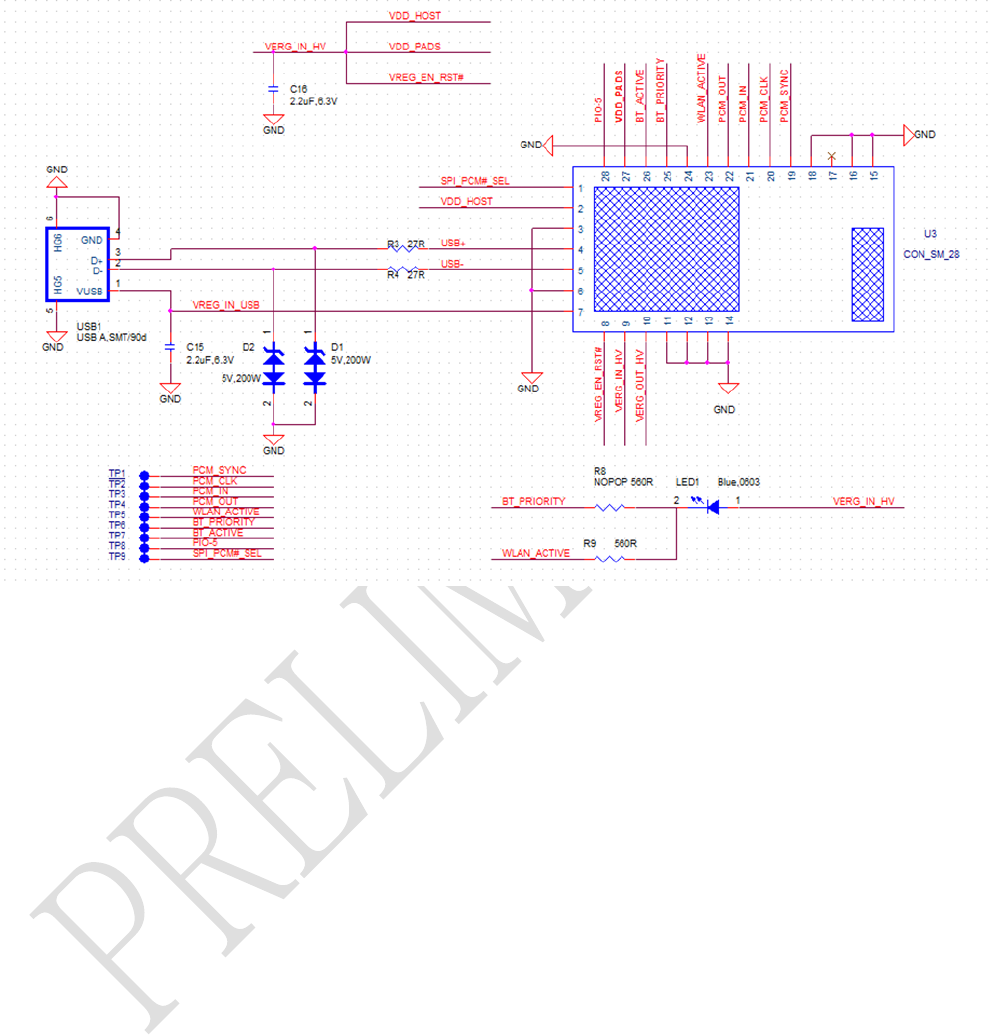
BT800 Hardware Integration Guide
Version 0.2
Americas: +1-800-492-2320 Option 2
Europe: +44-1628-858-940
Hong Kong: +852-2923-0610
www.lairdtech.com/bluetooth
31
CONN-GUIDE-BT800_v0_2
13.1.2 USB dongle design example using BT800
Figure 19: USB Dongle Design Schematic
13.1.3 DC power supply options for using BT800 module
Using USB bus power (5V+/-10%)
Apply USB bus power (5V +/-10%) directly to the Pin-7 (VREG_IN_USB) and pull-high on Pin-8
(VREG_EN_RST#) to turn on the internal regulator. The BT800 module will generate 3.3V/1.8V
output on Pin-9 (VREG_IN_HV)/Pin-10 (VREG_OUT_HV) that can supply to the other DC pin of the
board.
Using DC power 3.3V
Leave the Pin-7 (VREG_IN_USB) no connection, power the on Pin-9 (VREG_IN_HV) with 3.3V and
pull-high on Pin-8 (VREG_EN_RST#) to turn on the internal regulator. The BT800 module will
generate 1.8V output on Pin-10 (VREG_OUT_HV) which can supply to the other DC pin of the
board.
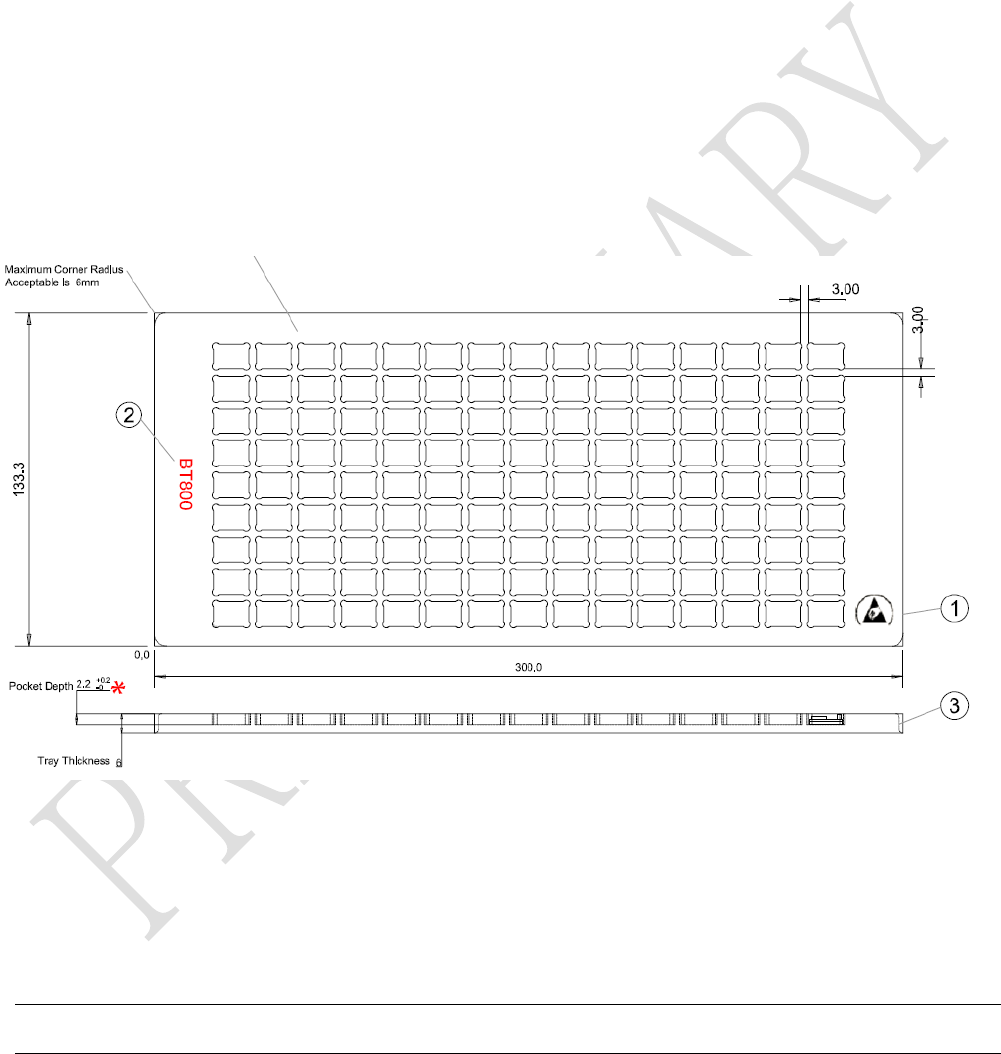
BT800 Hardware Integration Guide
Version 0.2
Americas: +1-800-492-2320 Option 2
Europe: +44-1628-858-940
Hong Kong: +852-2923-0610
www.lairdtech.com/bluetooth
32
CONN-GUIDE-BT800_v0_2
14 APPLICATION NOTE FOR SURFACE MOUNT MODULES
Introduction 14.1
Laird Technologies surface mount modules are designed to conform to all major manufacturing
guidelines. This application note is intended to provide additional guidance beyond the information
that is presented in the User Manual. This Application Note is considered a living document and will be
updated as new information is presented.
The modules are designed to meet the needs of a number of commercial and industrial applications.
They are easy to manufacture and conform to current automated manufacturing processes.
Shipping tray 14.2
Modules are shipped in ESD (Electrostatic Discharge) safe trays that can be loaded into most
manufacturers pick and place machines. Layouts of the trays are provided in.
Figure 20: Shipping tray layout
Reflow Parameters 14.3
Laird Technologies surface mount modules are designed to be easily manufactured, including reflow
soldering to a PCB. Ultimately it is the responsibility of the customer to choose the appropriate solder
paste and to ensure oven temperatures during reflow meet the requirements of the solder paste. Laird
Technologies’ surface mount modules conform to J-STD-020D1 standards for reflow temperatures.
Important: During reflow, modules should not be above 260° and not for more than 30 seconds.
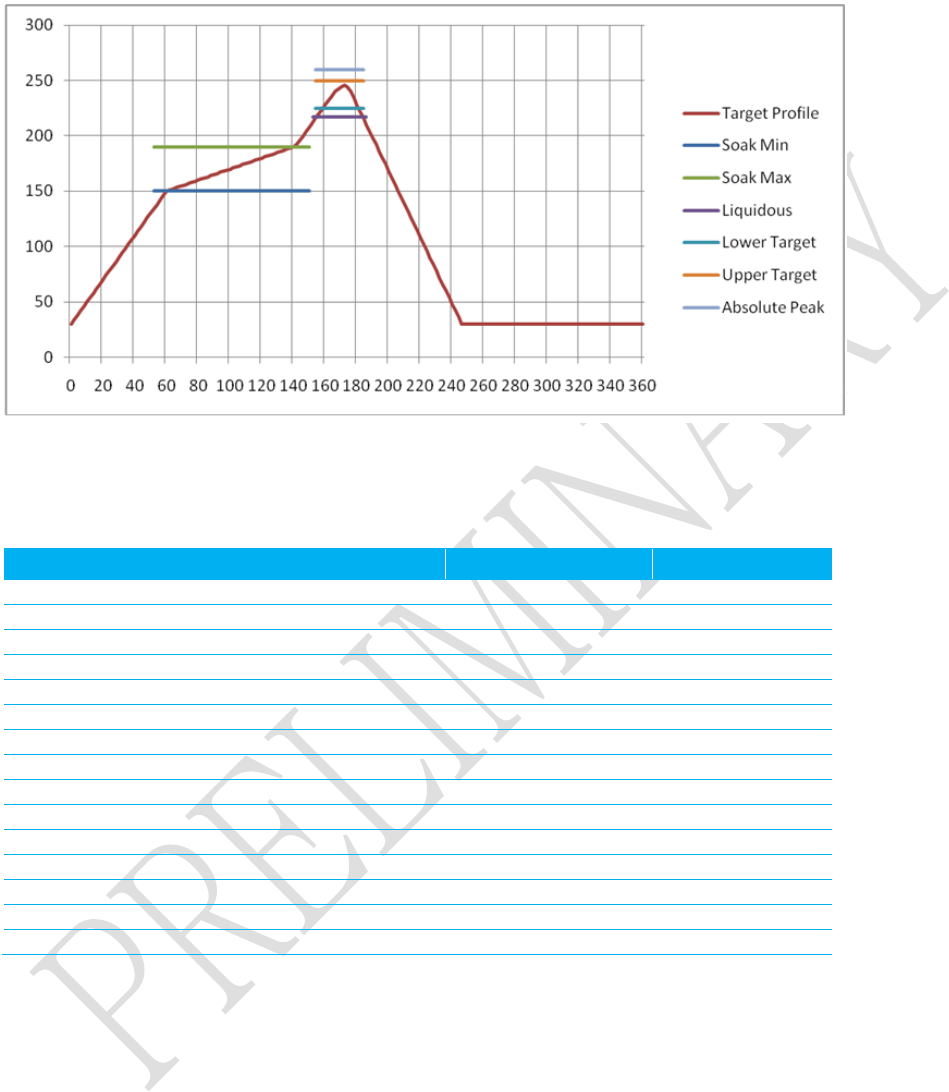
BT800 Hardware Integration Guide
Version 0.2
Americas: +1-800-492-2320 Option 2
Europe: +44-1628-858-940
Hong Kong: +852-2923-0610
www.lairdtech.com/bluetooth
33
CONN-GUIDE-BT800_v0_2
Figure 14-21: Recommended Reflow Temperature
Temperatures should not exceed the minimums or maximums presented in Table 16.
Table 16: Recommended Maximum and minimum temperatures
Specification
Value
Unit
Temperature Inc./Dec. Rate (max)
1~3
°C / Sec
Temperature Decrease rate (goal)
2-4
°C / Sec
Soak Temp Increase rate (goal)
.5 - 1
°C / Sec
Flux Soak Period (Min)
70
Sec
Flux Soak Period (Max)
120
Sec
Flux Soak Temp (Min)
150
°C
Flux Soak Temp (max)
190
°C
Time Above Liquidous (max)
70
Sec
Time Above Liquidous (min)
50
Sec
Time In Target Reflow Range (goal)
30
Sec
Time At Absolute Peak (max)
5
Sec
Liquidous Temperature (SAC305)
218
°C
Lower Target Reflow Temperature
240
°C
Upper Target Reflow Temperature
250
°C
Absolute Peak Temperature
260
°C
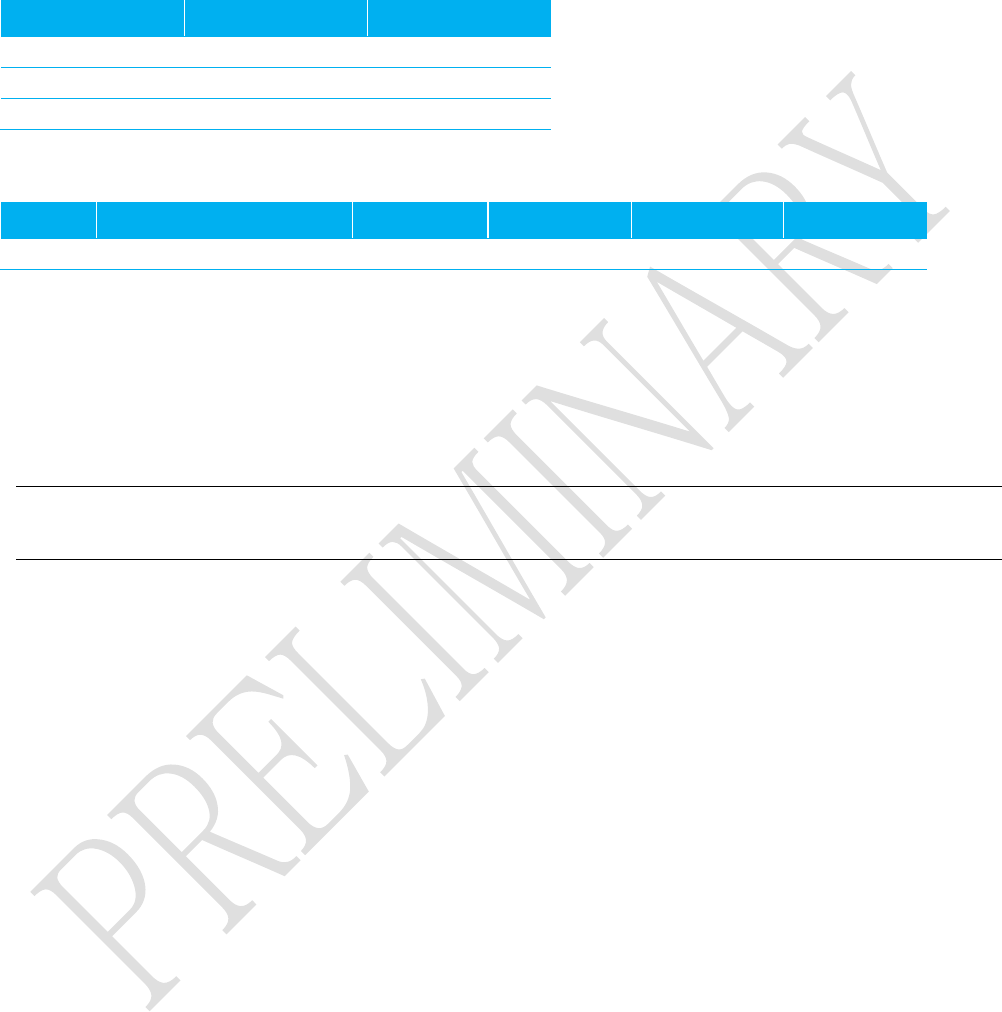
BT800 Hardware Integration Guide
Version 0.2
Americas: +1-800-492-2320 Option 2
Europe: +44-1628-858-940
Hong Kong: +852-2923-0610
www.lairdtech.com/bluetooth
34
CONN-GUIDE-BT800_v0_2
15 FCC AND IC REGULATORY
Model
US/FCC
CANADA/IC
BT800
SQGBT800
3147A-BT800
BT810
SQGBT800
3147A-BT800
BT820
SQGBT800
3147A-BT800
The BT800 family has been designed to operate with the antenna listed below having a maximum gain
of 0.5 dBi. The required antenna impedance is 50 ohms.
Item
Part Number
Mfg.
Type
Gain (dBi)
1
AT3216-B2R7HAA
ACX
Ceramic
0.5
Documentation Requirements 15.1
In order to ensure regulatory compliance, when integrating the BT800 into a host device, it is necessary
to meet the documentation requirements set forth by the applicable regulatory agencies. The following
sections (FCC, Industry Canada, and European Union) outline the information that may be included in
the user’s guide and external labels for the host devices into which the BT800 is integrated.
FCC
Note: You must place “Contains FCC ID: SQGBT800” on the host product in such a location that it
can be seen by an operator at the time of purchase.
User’s Guide Requirements
The BT800 complies with FCC Part 15 Rules for a Modular Approval. To leverage Laird’s grant, the
conditions below must be met for the host device into which the BT800 is integrated:
The transmitter module is not co-located with any other transmitter or antenna that is capable 1.
of simultaneous operation.
As long as the conditions above are met, further transmitter testing is typically not required. However,
the OEM integrator is still responsible for testing its end-product for any additional compliance
requirements required with this module installed, such as (but not limited to) digital device emissions
and PC peripheral requirements.
IMPORTANT!
In the event that the three conditions above cannot be met (for example certain device
configurations or co-location with another transmitter), then the FCC authorization is no
longer considered valid and the FCC ID cannot be used on the final product. In these
circumstances, the OEM integrator will be responsible for re-evaluating the end product
(including the transmitter) and obtaining a separate FCC authorization.
When using Laird’s FCC grant for the BT800, the integrator must include specific information
in the user’s guide for the device into which the BT800 is integrated. The integrator must not
provide information to the end user regarding how to install or remove this RF module in the
user’s manual of the device into which the BT800 is integrated. The following FCC
statements must be added in there entirety and without modification into a prominent
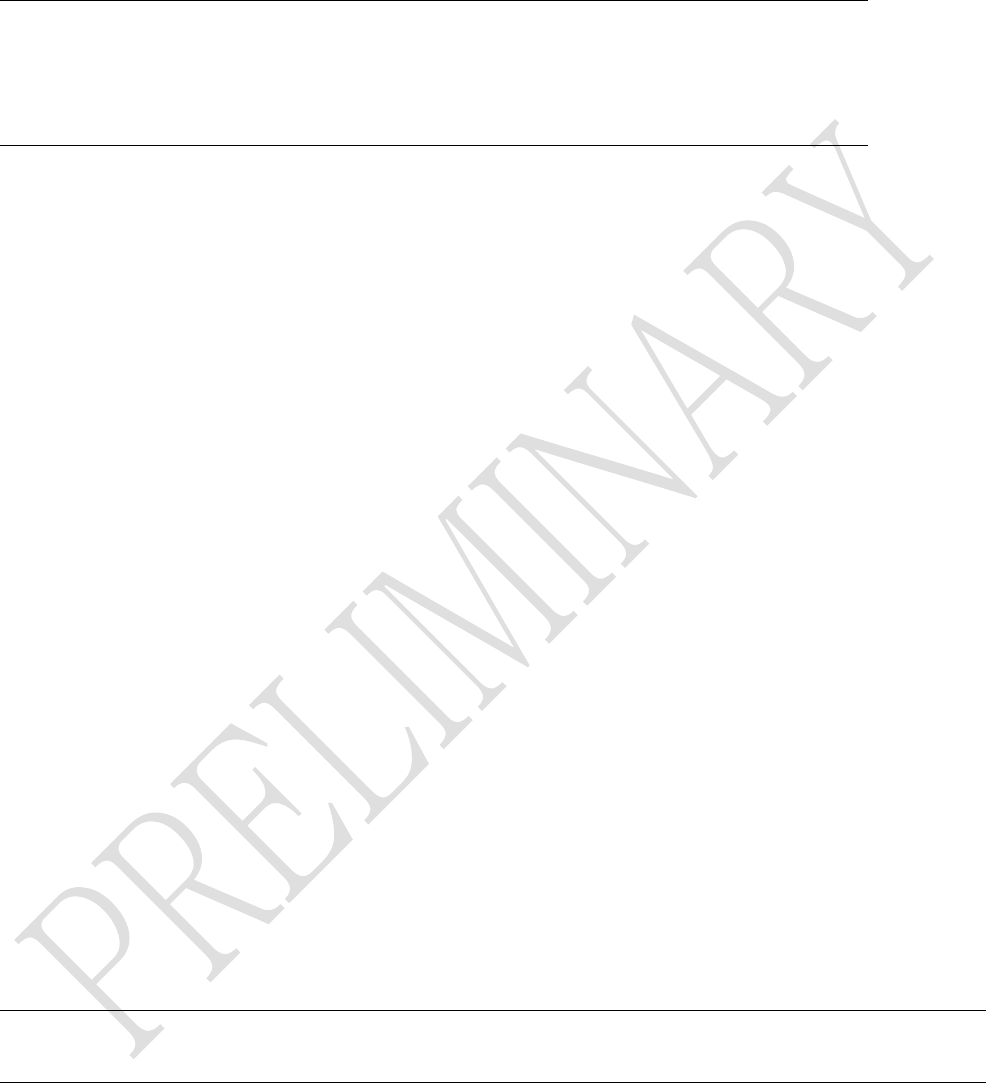
BT800 Hardware Integration Guide
Version 0.2
Americas: +1-800-492-2320 Option 2
Europe: +44-1628-858-940
Hong Kong: +852-2923-0610
www.lairdtech.com/bluetooth
35
CONN-GUIDE-BT800_v0_2
place in the user’s guide for the device into which the BT800 is integrated:
IMPORTANT NOTE: The product comply with the US/Canada portable RF exposure limit set forth
for an uncontrolled environment and are safe for intended operation as
described in this manual. The further RF exposure reduction can be achieved
if the product can be kept as far as possible from the user body or set the
device to lower output power if such function is available.
Federal Communication Commission Interference Statement
This equipment has been tested and found to comply with the limits for a Class B digital
device, pursuant to Part 15 of the FCC Rules. These limits are designed to provide
reasonable protection against harmful interference in a residential installation. This
equipment generates, uses, and can radiate radio frequency energy and, if not installed
and used in accordance with the instructions, may cause harmful interference to radio
communications. However, there is no guarantee that interference will not occur in a
particular installation. If this equipment does cause harmful interference to radio or
television reception, which can be determined by turning the equipment off and on, the
user is encouraged to try to correct the interference by one of the following measures:
Reorient or relocate the receiving antenna.
1.
Increase the separation between the equipment and receiver.
2.
Connect the equipment into an outlet on a circuit different from that to which the
3.
receiver is connected.
Consult the dealer or an experienced radio/TV technician for help.
4.
FCC Caution: Any changes or modifications not expressly approved by the party
responsible for compliance could void the user's authority to operate this equipment.
This device complies with Part 15 of the FCC Rules. Operation is subject to the following two
conditions: (1) This device may not cause harmful interference, and (2) this device must
accept any interference received, including interference that may cause undesired
operation.
IMPORTANT NOTE: FCC Radiation Exposure Statement:
The product comply with the US/Canada portable RF exposure limit set forth for an
uncontrolled environment and are safe for intended operation as described in this
manual. The further RF exposure reduction can be achieved if the product can be
kept as far as possible from the user body or set the device to lower output power if
such function is available.
Industry Canada
Note: You must place “Contains IC: 3147A-BT800” on the host product in such a location that it can
be seen by an operator at the time of purchase.
Radiation Exposure Statement:
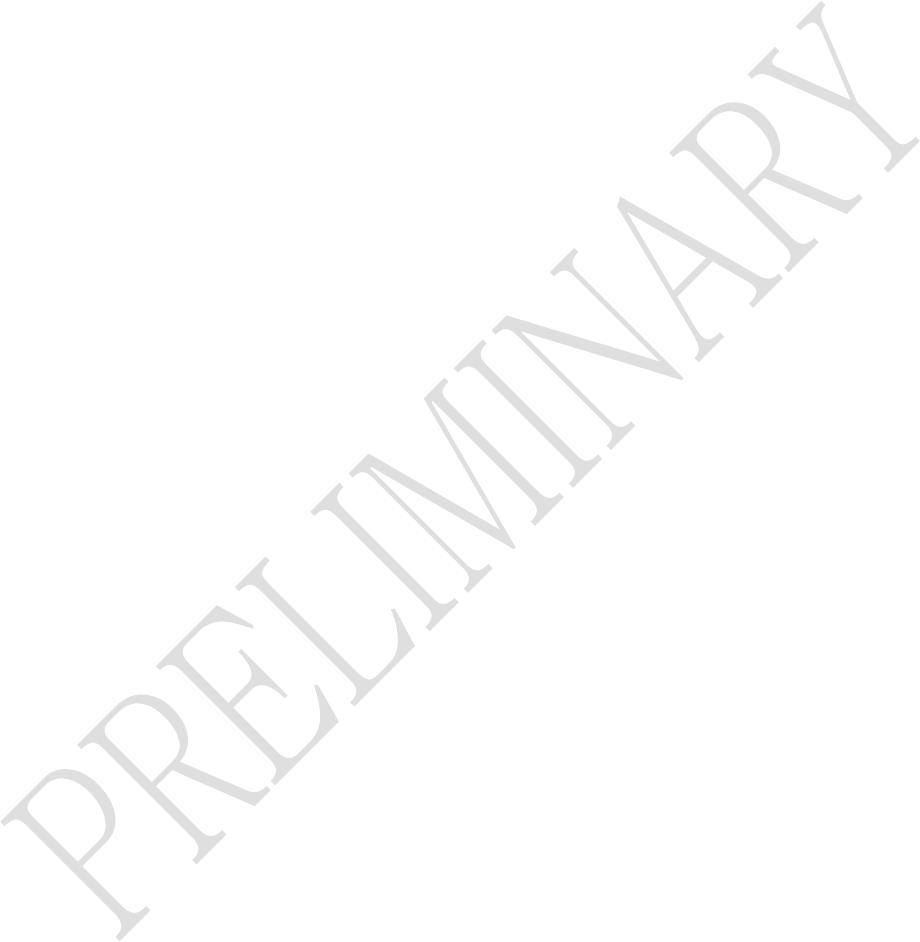
BT800 Hardware Integration Guide
Version 0.2
Americas: +1-800-492-2320 Option 2
Europe: +44-1628-858-940
Hong Kong: +852-2923-0610
www.lairdtech.com/bluetooth
36
CONN-GUIDE-BT800_v0_2
The product comply with the Canada portable RF exposure limit set forth for an uncontrolled
environment and are safe for intended operation as described in this manual. The further RF exposure
reduction can be achieved if the product can be kept as far as possible from the user body or set the
device to lower output power if such function is available.
Dé claration d'exposition aux radiations:
Le produit est conforme aux limites d'exposition pour les appareils portables RF pour les Etats-Unis et le
Canada é tablies pour un environnement non contrô lé .
Le produit est sûr pour un fonctionnement tel que dé crit dans ce manuel. La ré duction aux expositions
RF peut ê tre augmenté e si l'appareil peut ê tre conservé aussi loin que possible du corps de l'utilisateur
ou que le dispositif est ré glé sur la puissance de sortie la plus faible si une telle fonction est disponible.
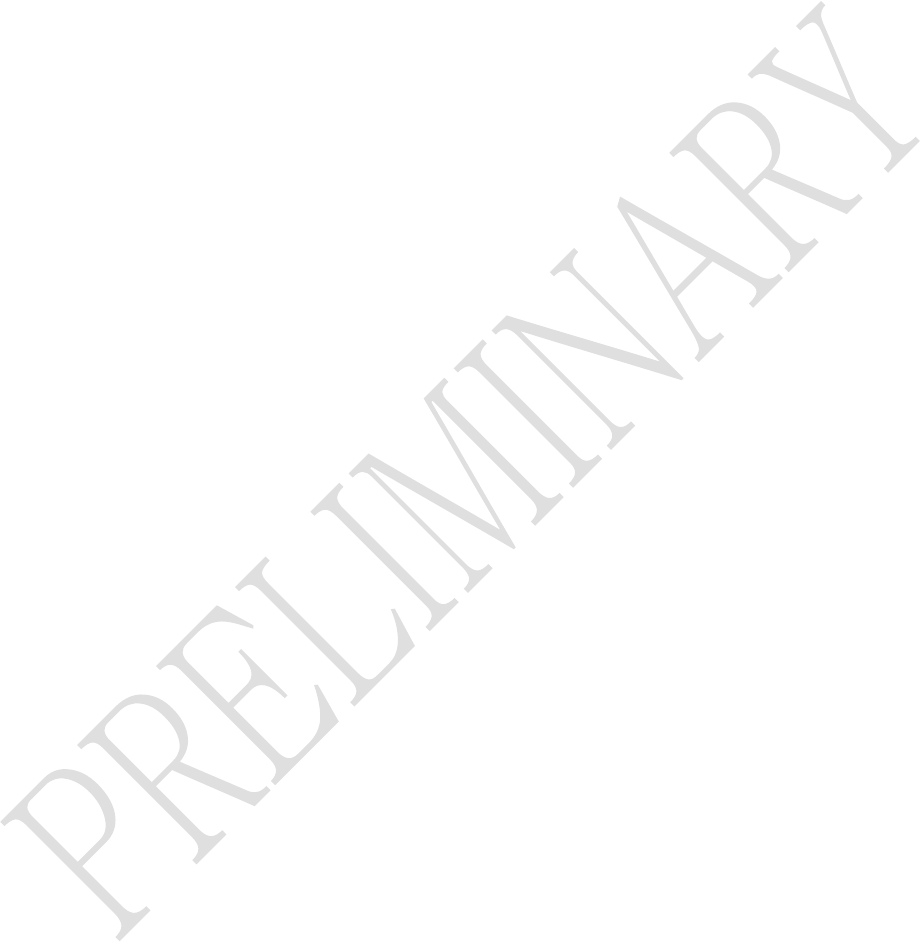
BT800 Hardware Integration Guide
Version 0.2
Americas: +1-800-492-2320 Option 2
Europe: +44-1628-858-940
Hong Kong: +852-2923-0610
www.lairdtech.com/bluetooth
37
CONN-GUIDE-BT800_v0_2
This radio transmitter (Contains IC: 3147A-BT800) has been approved by Industry Canada to operate
with the antenna types listed in table above with the maximum permissible gain and required antenna
impedance for each antenna type indicated. Antenna types not included in this list, having a gain
greater than the maximum gain indicated for that type, are strictly prohibited for use with this device.
Le pré sent é metteur radio (Contains IC: 3147A-BT800) a é té approuvé par Industrie Canada pour
fonctionner avec les types d'antenne é numé ré s ci-dessous et ayant un gain admissible maximal et
l'impé dance requise pour chaque type d'antenne. Les types d'antenne non inclus dans cette liste, ou
dont le gain est supé rieur au gain maximal indiqué , sont strictement interdits pour l'exploitation de
l'é metteur.
Under Industry Canada regulations, this radio transmitter may only operate using an antenna of a type
and maximum (or lesser) gain approved for the transmitter by Industry Canada. To reduce potential
radio interference to other users, the antenna type and its gain should be so chosen that the equivalent
isotropically radiated power (e.i.r.p.) is not more than that necessary for successful communication.
Conformé ment à la ré glementation d'Industrie Canada, le pré sent é metteur radio peut fonctionner
avec une antenne d'un type et d'un gain maximal (ou infé rieur) approuvé pour l'é metteur par Industrie
Canada. Dans le but de ré duire les risques de brouillage radioé lectrique à l'intention des autres
utilisateurs, il faut choisir le type d'antenne et son gain de sorte que la puissance isotrope rayonné e
é quivalente (p.i.r.e.) ne dé passe pas l'intensité né cessaire à l'é tablissement d'une communication
satisfaisante.
This device complies with Industry Canada license-exempt RSS standard(s). Operation is subject to the
following two conditions: (1) this device may not cause interference, and (2) this device must accept
any interference, including interference that may cause undesired operation of the device.
Le pré sent appareil est conforme aux CNR d'Industrie Canada applicables aux appareils radio exempts
de licence. L'exploitation est autorisé e aux deux conditions suivantes : (1) l'appareil ne doit pas produire
de brouillage, et (2) l'utilisateur de l'appareil doit accepter tout brouillage radioé lectrique subi, mê me si
le brouillage est susceptible d'en compromettre le fonctionnement.
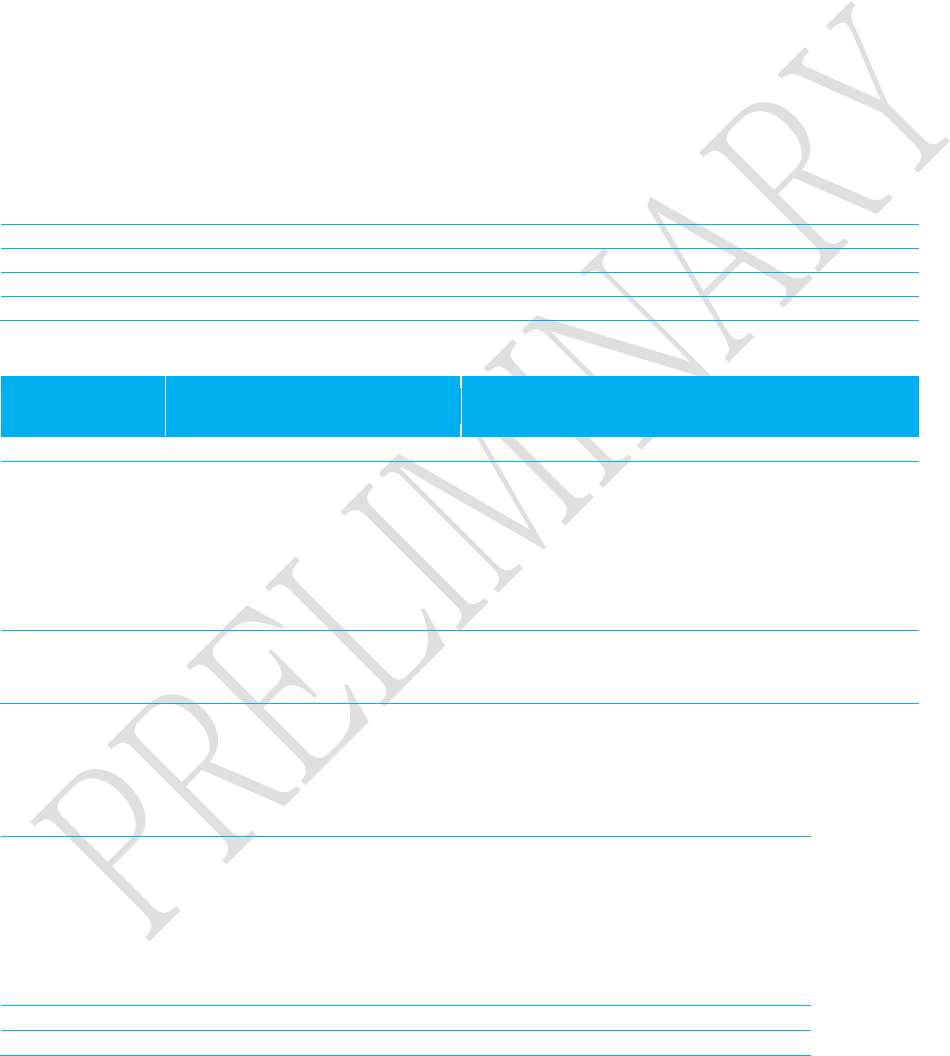
BT800 Hardware Integration Guide
Version 0.2
Americas: +1-800-492-2320 Option 2
Europe: +44-1628-858-940
Hong Kong: +852-2923-0610
www.lairdtech.com/bluetooth
38
CONN-GUIDE-BT800_v0_2
16 EUROPEAN UNION REGULATORY
The BT800 has been tested for compliance with relevant standards for the EU market. BT800 module was
tested with a 0.5 dBi chip antenna.
The OEM should consult with a qualified test house before entering their device into an EU member
country to make sure all regulatory requirements have been met for their complete device.
Reference the Declaration of Conformities listed below for a full list of the standards that the modules
were tested to. Test reports are available upon request.
17 EU DECLARATIONS OF CONFORMITY
BT800 / BT810 / BT820 17.1
Manufacturer:
Laird
Product:
BT800 / BT810 / BT820
EU Directive:
RTTE 1995/5/EC
Conformity Assessment:
Annex IV
Reference standards used for presumption of conformity:
Article
Number
Requirement
Reference standard(s)
3.1a
Health and Safety
EN60950-1:2006+A11:2009+A1:2010+A12:2011
3.1b
Protection requirements
with respect to
electromagnetic
compatibility
EN 301 489-1 V1.9.2 (2011-09)
EN 301 489-17 V2.2.1 (2012-09)
Emissions:
EN55022:2006/A1:2007 (Class B)
Immunity:
EN61000-4-2:2009
EN61000-4-3:2006/A1:2008/A2:2010
3.2
Means of the efficient use of
the radio frequency
spectrum
EN 300 328 V1.8.1 (2012-06)
Declaration:
We, Laird, declare under our sole responsibility that the essential radio test suites have been carried out
and that the above product to which this declaration relates is in conformity with all the applicable
essential requirements of Article 3 of the EU Directive 1999/5/EC, when used for its intended purpose.
Place of Issue:
Laird
Saturn House, Mercury Park
Wooburn Green
HP100HH,
United Kingdom
tel: +44 (0)1628 858 940
fax: +44 (0)1628 528 382
Date of Issue:
July 2013
Name of Authorized Person:
Andrew Dobbing, Engineering Manager
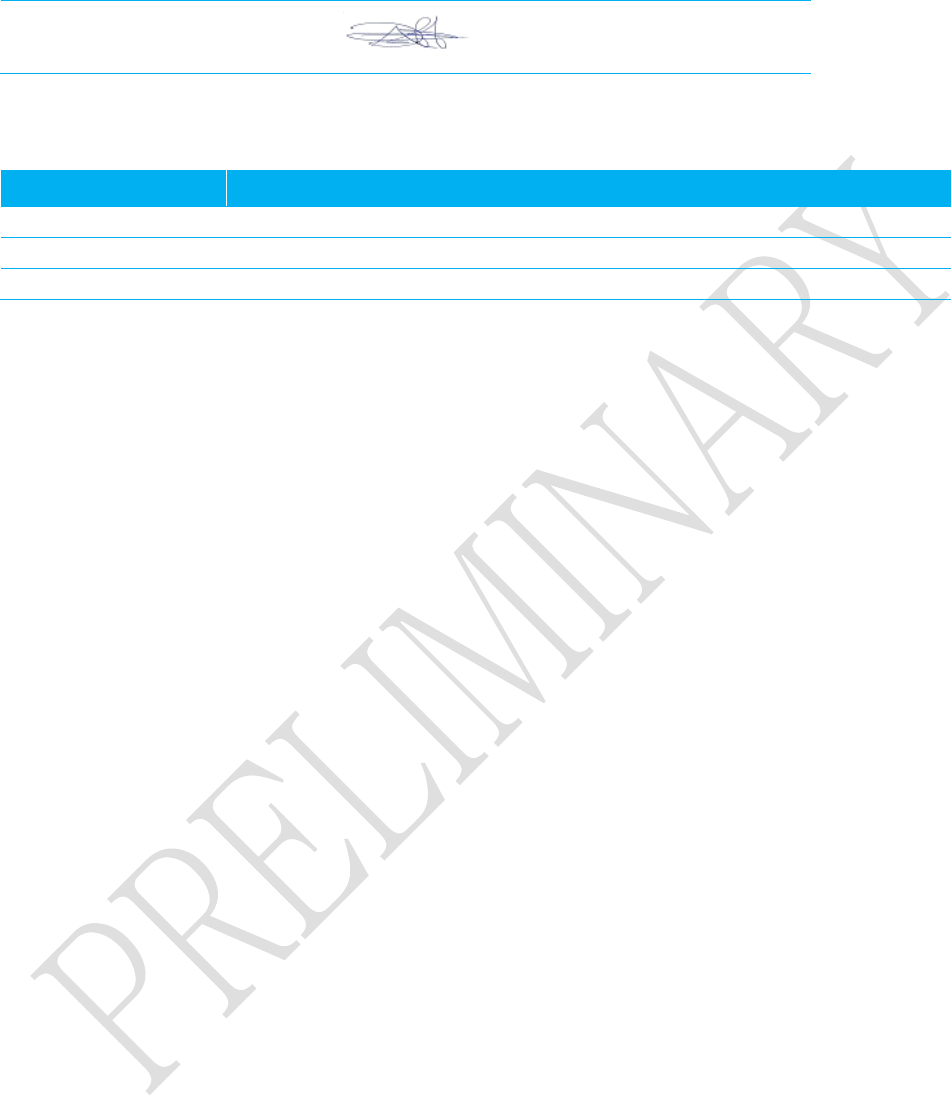
BT800 Hardware Integration Guide
Version 0.2
Americas: +1-800-492-2320 Option 2
Europe: +44-1628-858-940
Hong Kong: +852-2923-0610
www.lairdtech.com/bluetooth
39
CONN-GUIDE-BT800_v0_2
Signature:
18 ORDERING INFORMATION
Part Number
Description
BT800
BTv4.0 Dual Mode USB HCI Module
BT810
BTv4.0 Dual Mode USB HCI Module (BlueGiga BT111 footprint)
BT820
BTv4.0 Dual Mode USB Dongle
General Comments 18.1
This is a preliminary datasheet. Please check with Laird for the latest information before commencing a
design. If in doubt, ask.
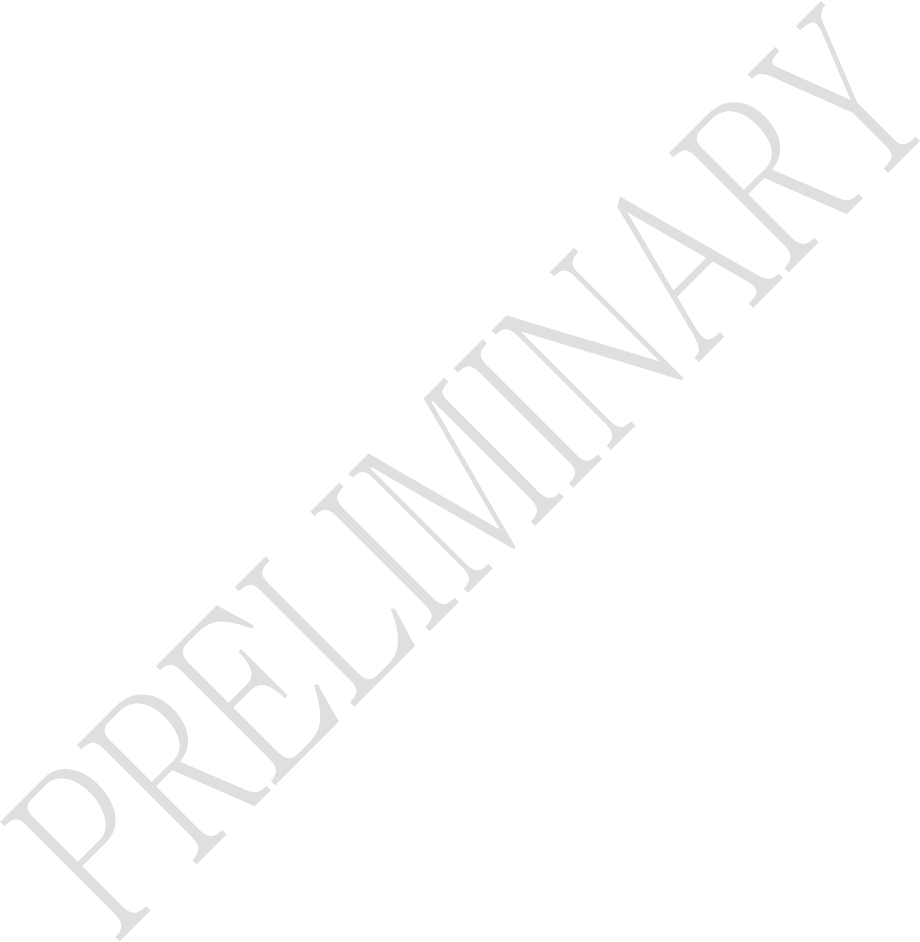
BT800 Hardware Integration Guide
Version 0.2
Americas: +1-800-492-2320 Option 2
Europe: +44-1628-858-940
Hong Kong: +852-2923-0610
www.lairdtech.com/bluetooth
40
CONN-GUIDE-BT800_v0_2
19 BLUETOOTH SIG APPROVALS
TBC
Copyright © 2013 Laird Technologies, Inc. All rights reserved.
The information contained in this manual and the accompanying software programs are copyrighted and all rights
are reserved by Laird Technologies, Inc. Laird Technologies, Inc. reserves the right to make periodic modifications of
this product without obligation to notify any person or entity of such revision. Copying, duplicating, selling, or
otherwise distributing any part of this product or accompanying documentation/software without the prior consent of
an authorized representative of Laird Technologies, Inc. is strictly prohibited.
All brands and product names in this publication are registered trademarks or trademarks of their respective holders.
This material is preliminary Information furnished by Laird Technologies in this specification is believed to be accurate.
Devices sold by Laird Technologies are covered by the warranty and patent indemnification provisions appearing in
its Terms of Sale only. Laird Technologies makes no warranty, express, statutory, and implied or by description,
regarding the information set forth herein. Laird Technologies reserves the right to change specifications at any time
and without notice. Laird Technologies’ products are intended for use in normal commercial and industrial
applications. Applications requiring unusual environmental requirements such as military, medical life-support or
life-sustaining equipment are specifically not recommended without additional testing for such application.
Limited Warranty, Disclaimer, Limitation of Liability
